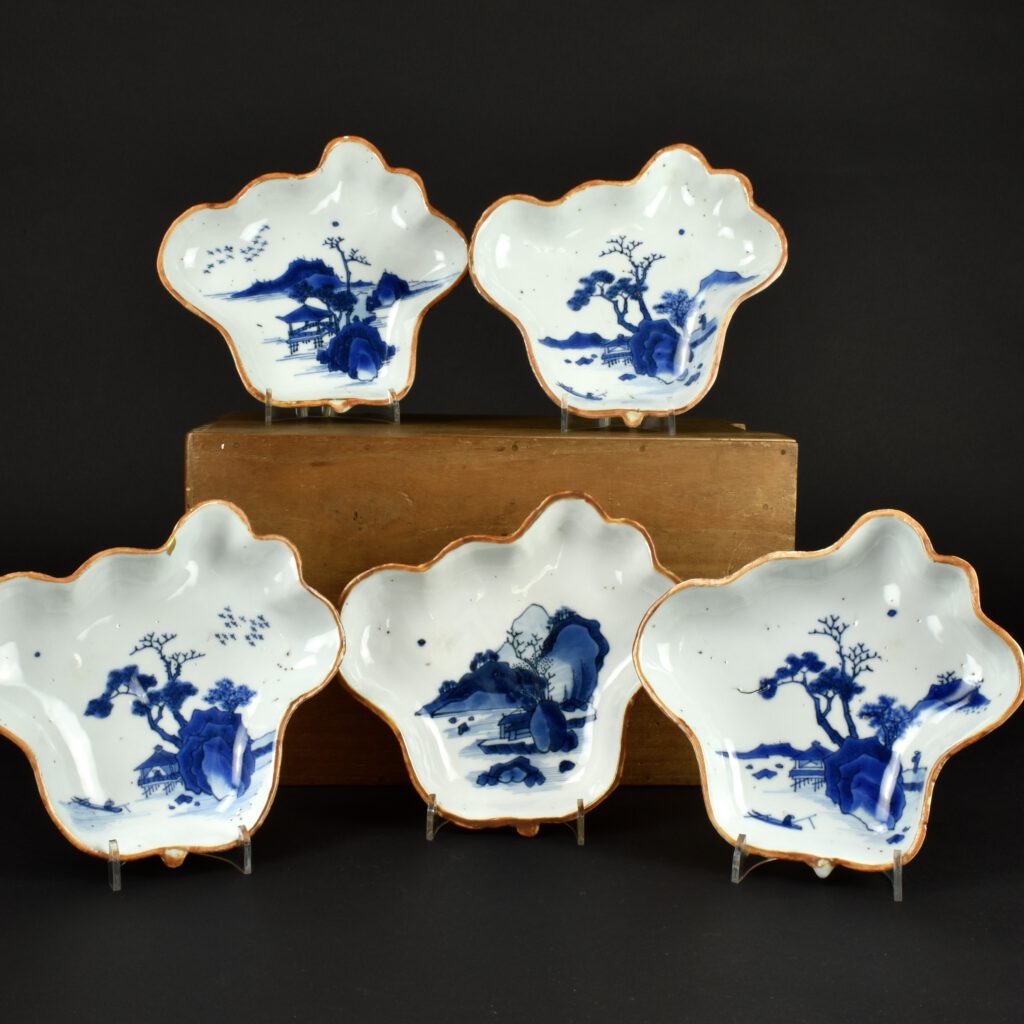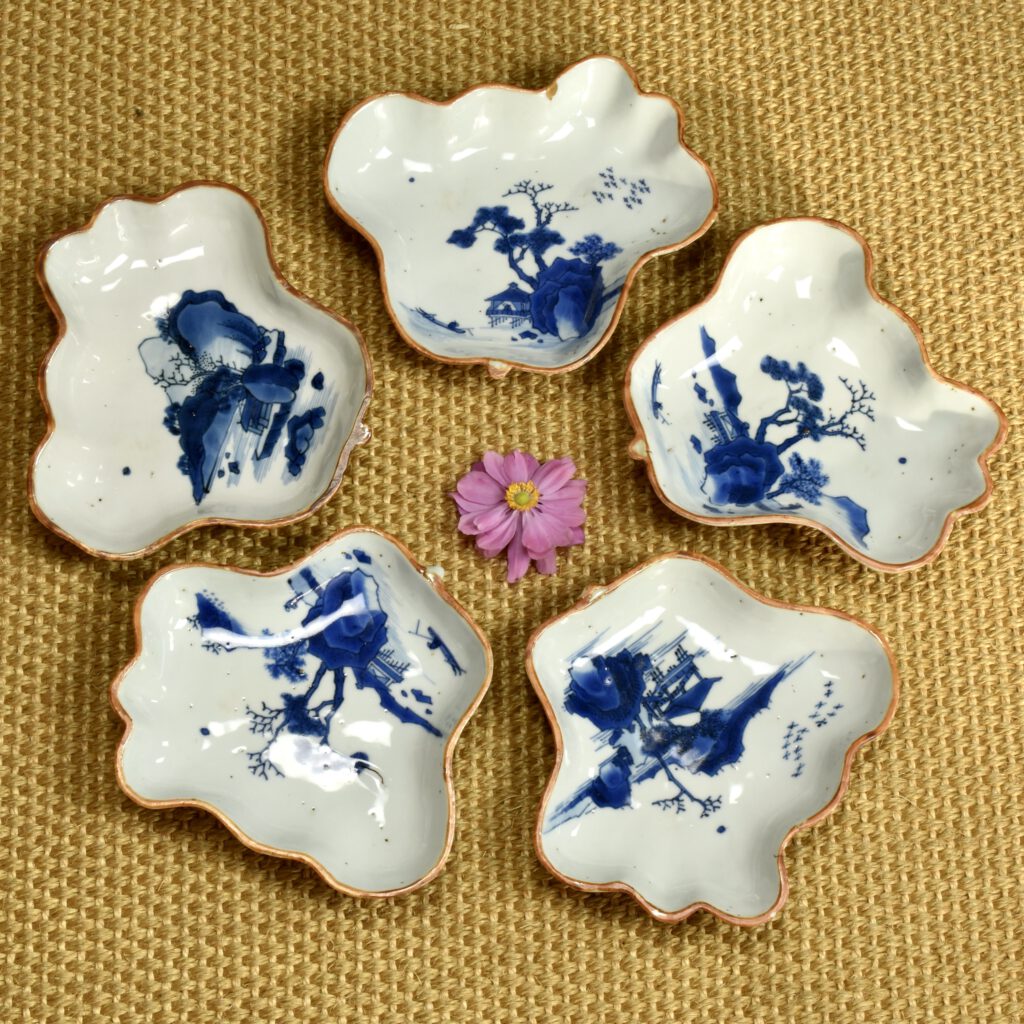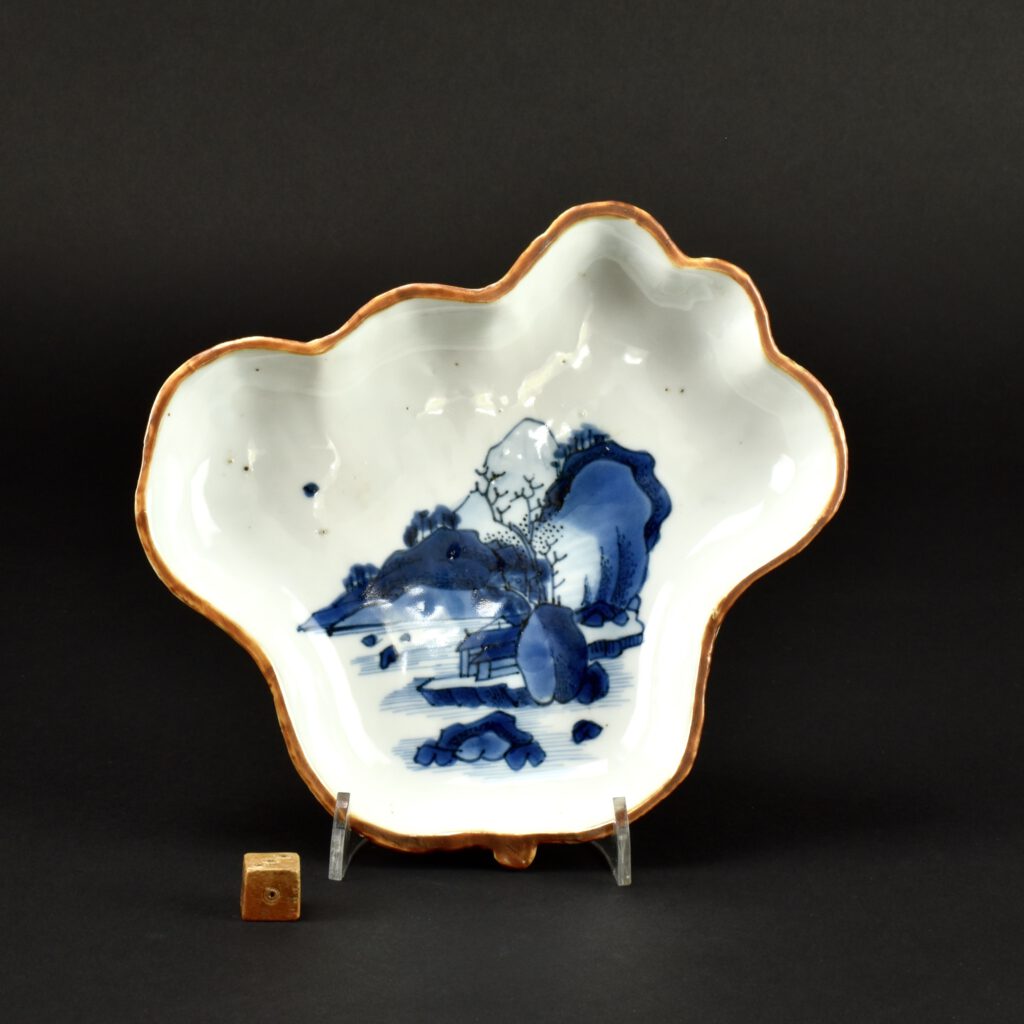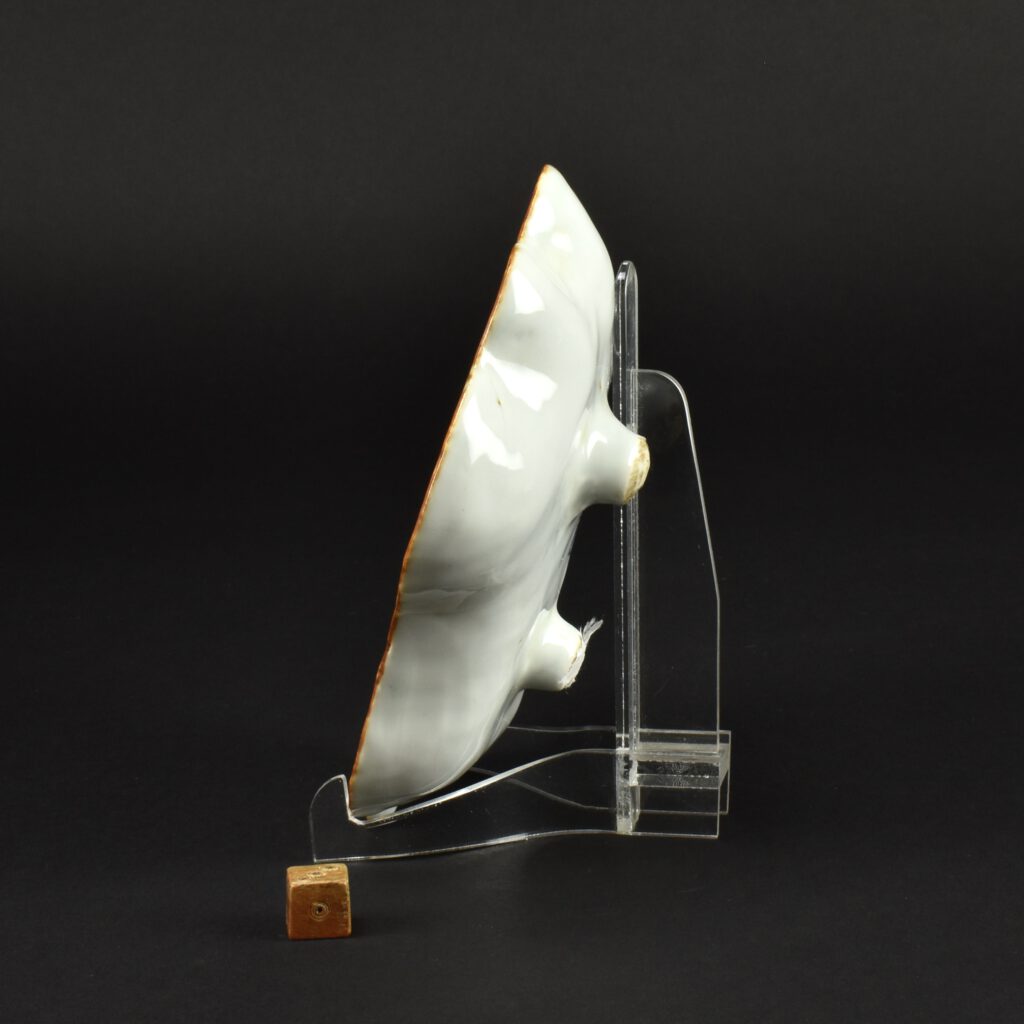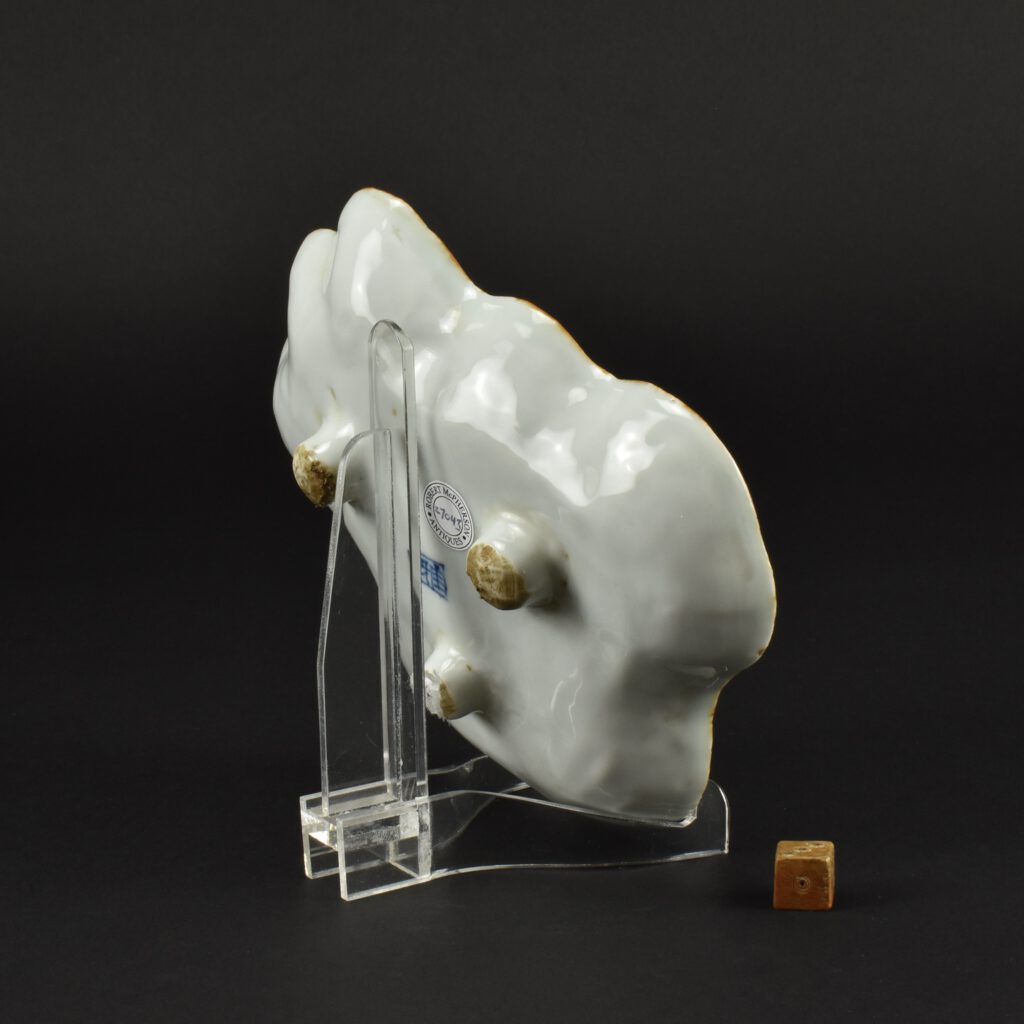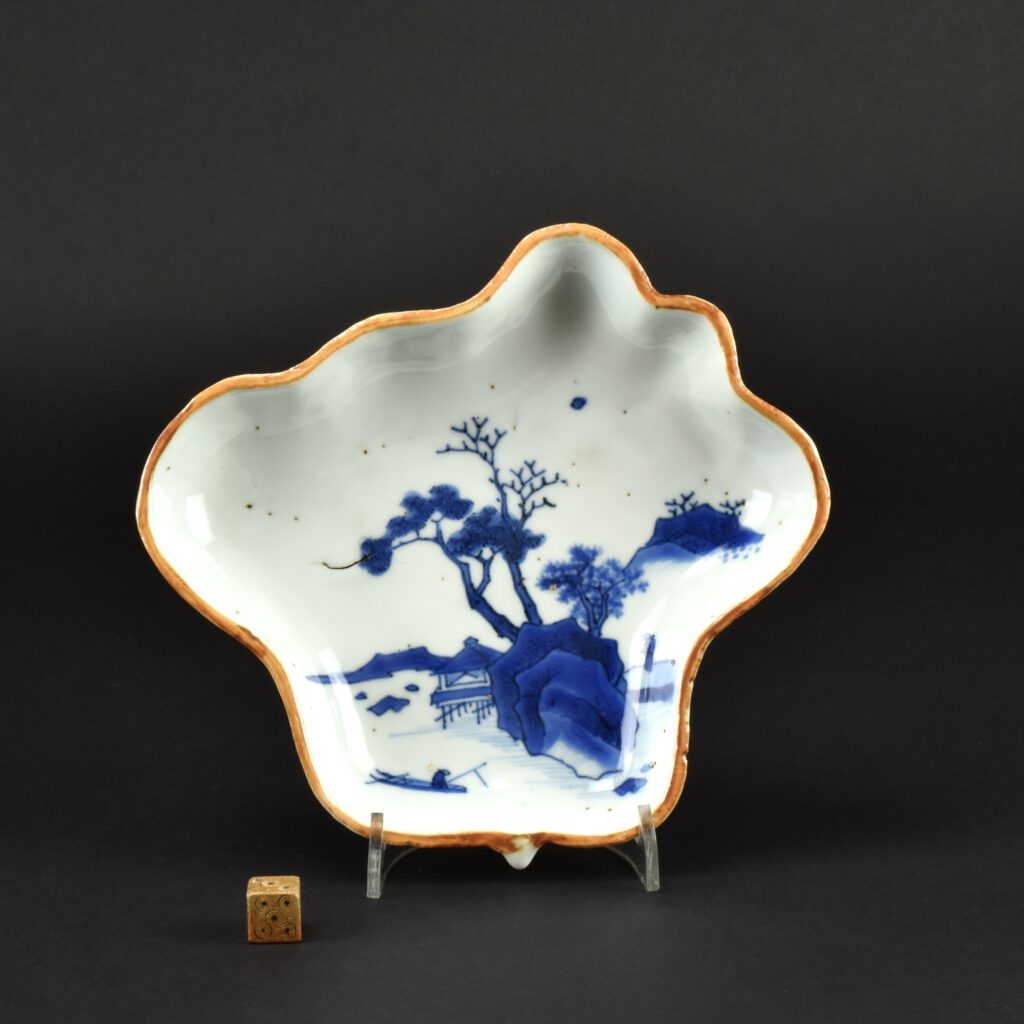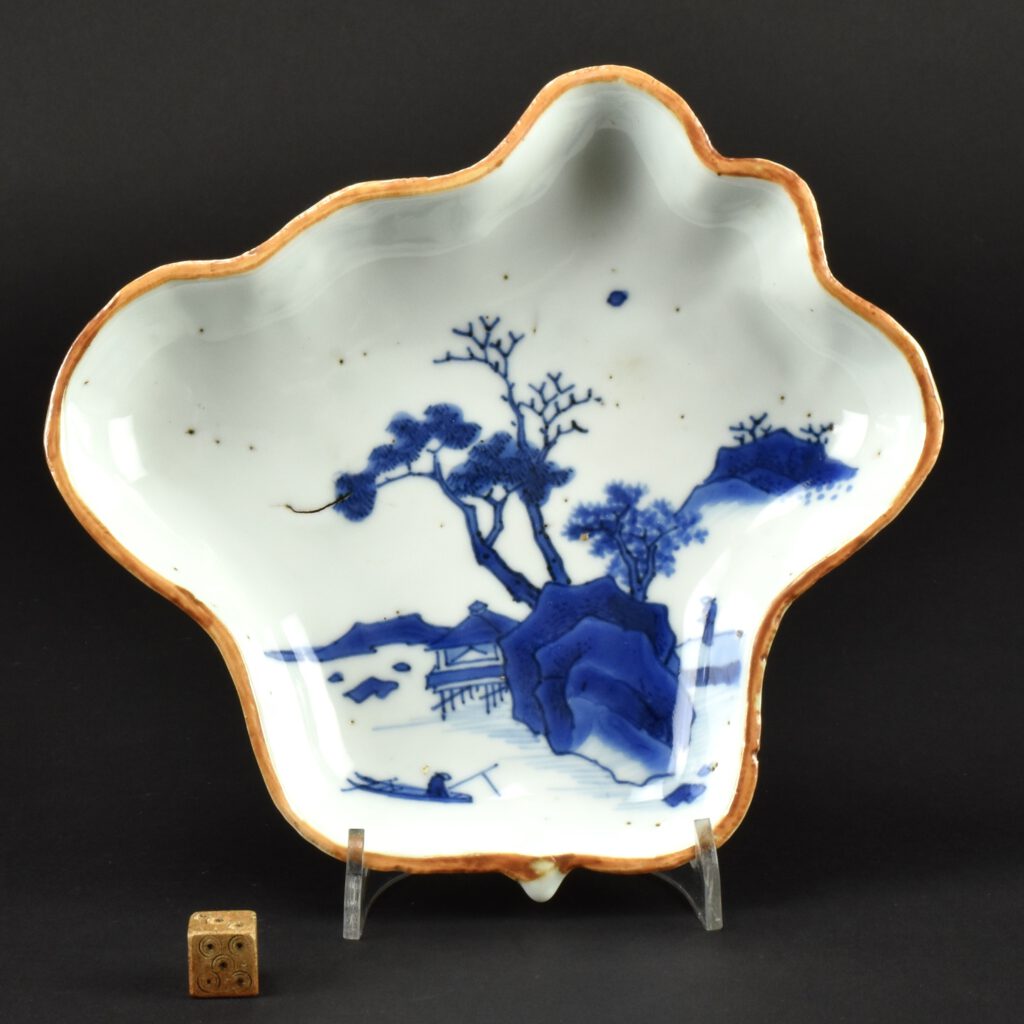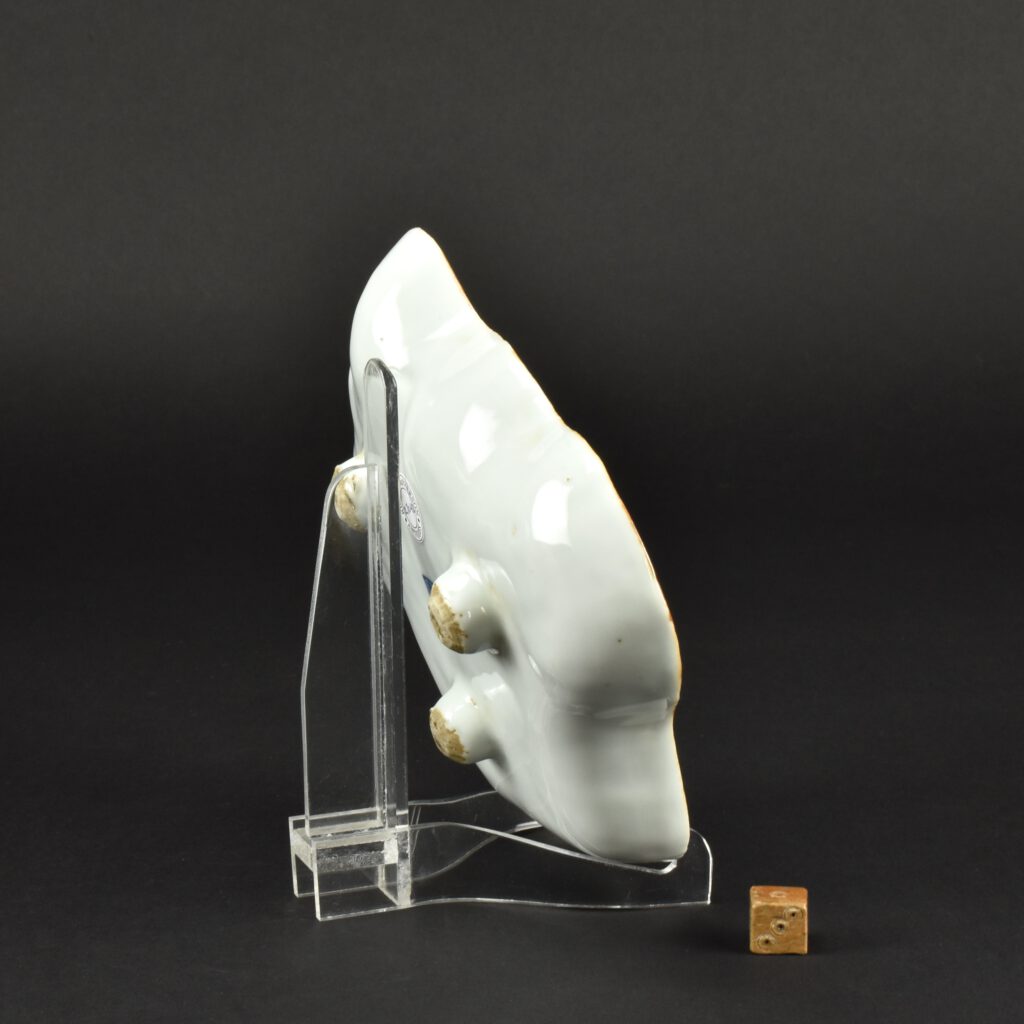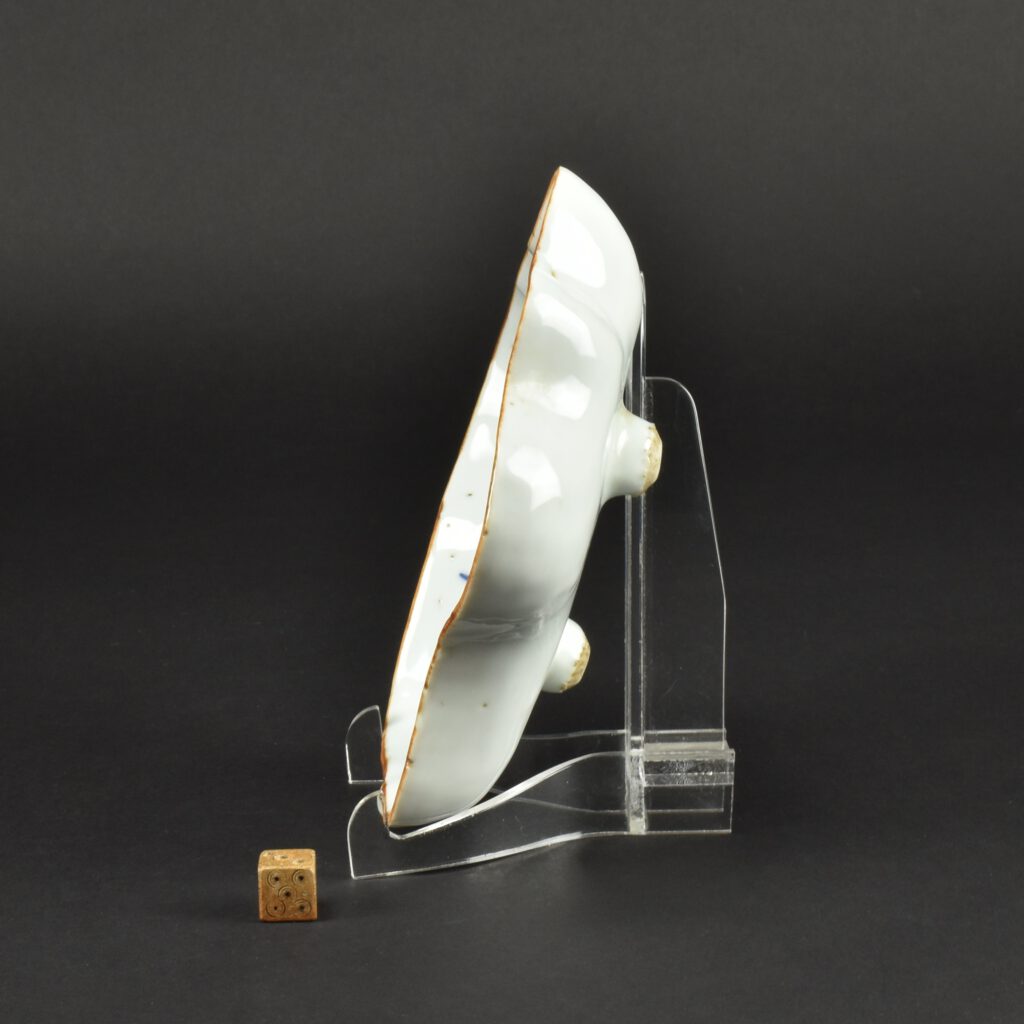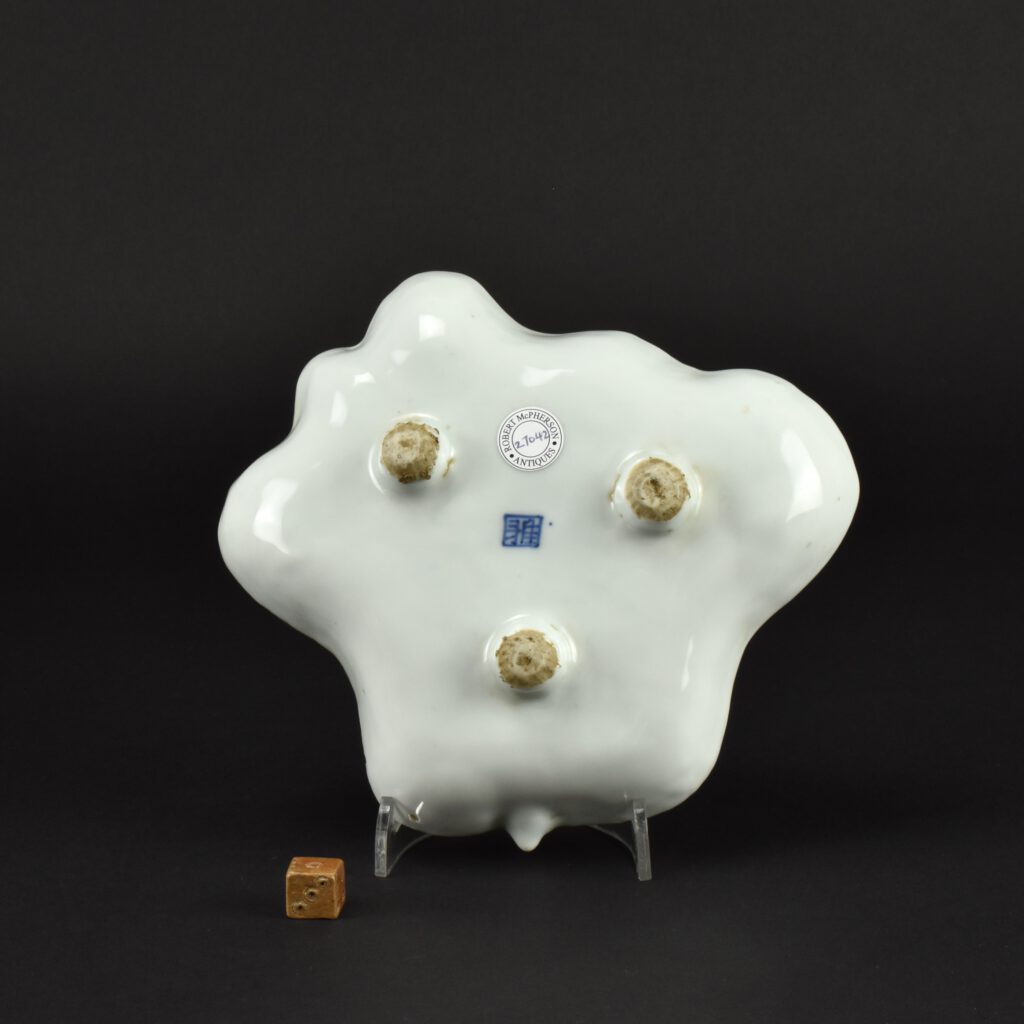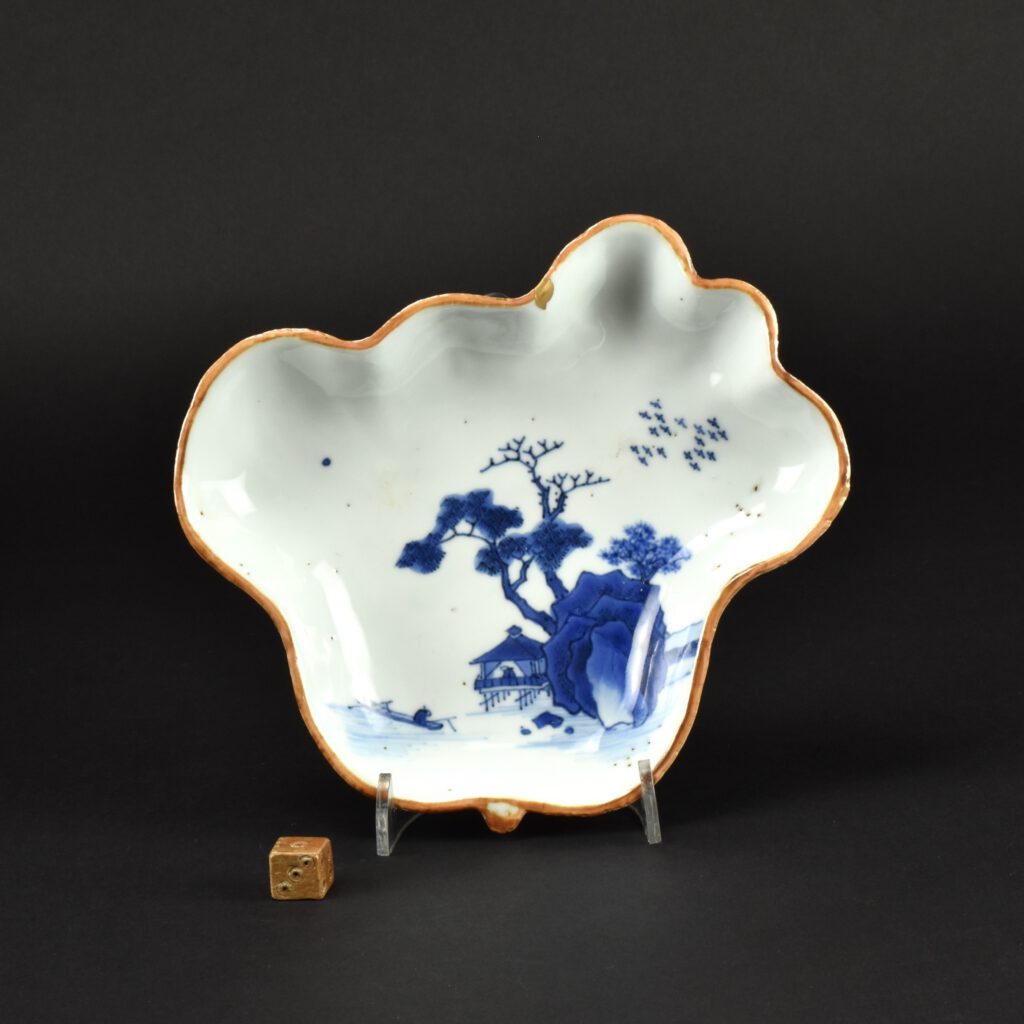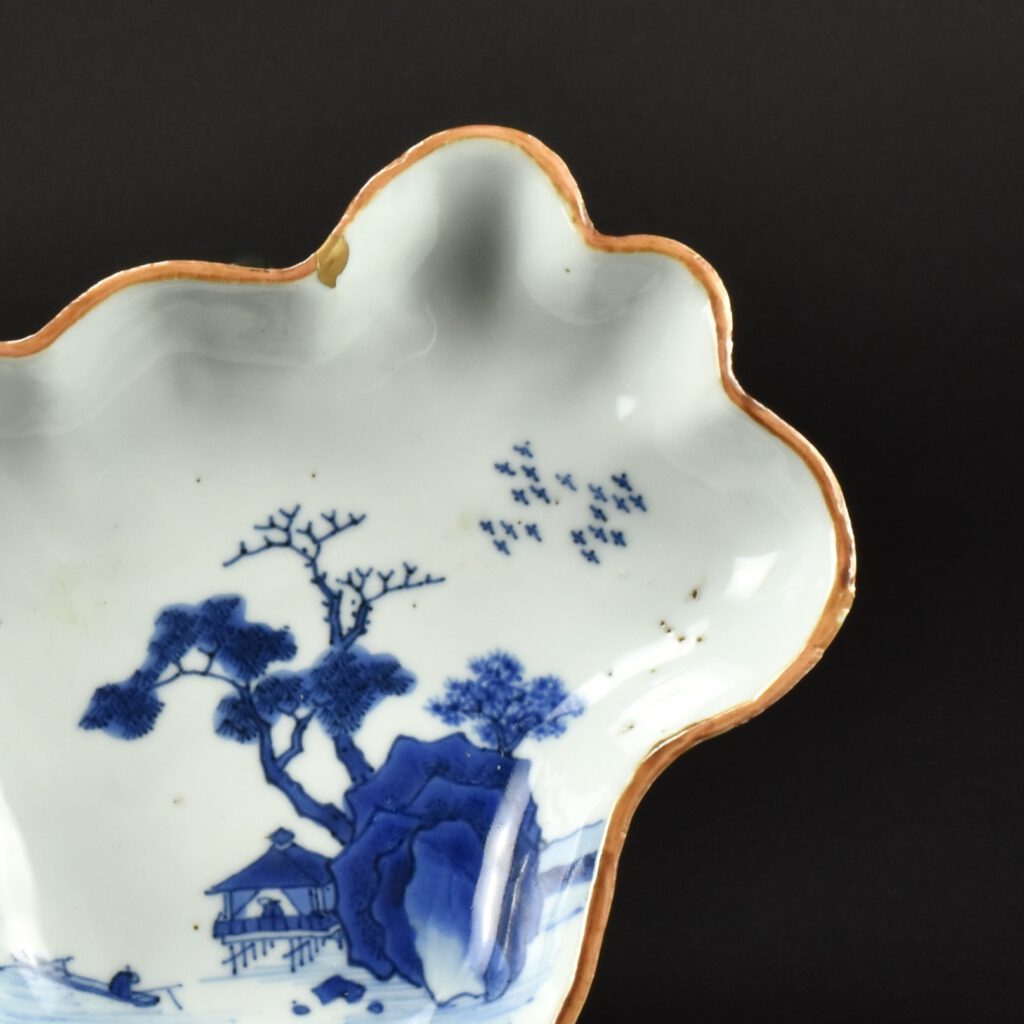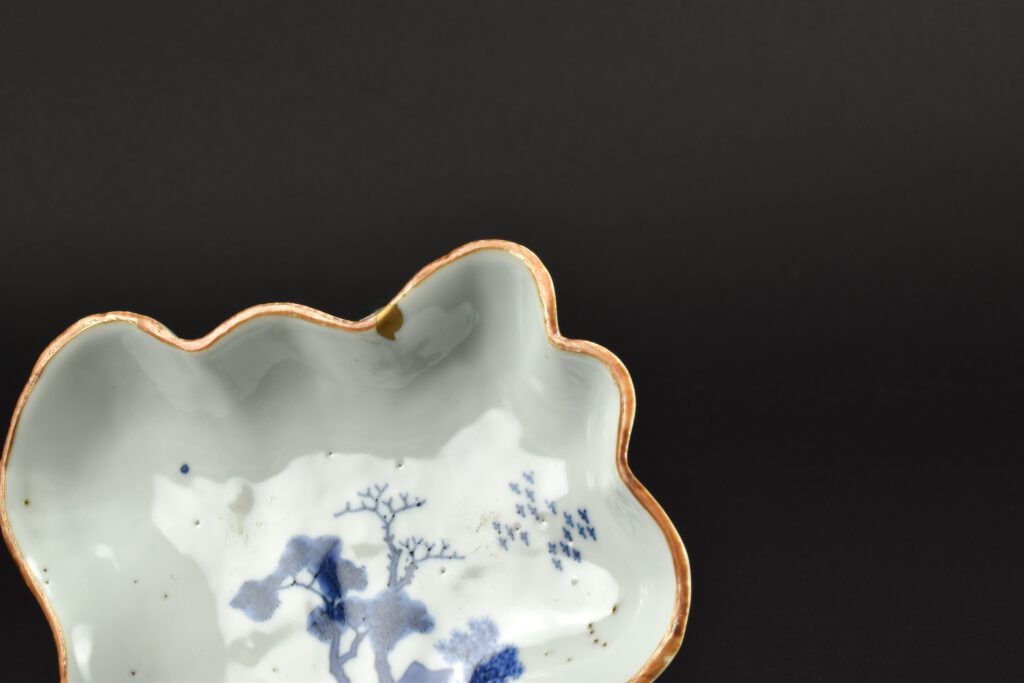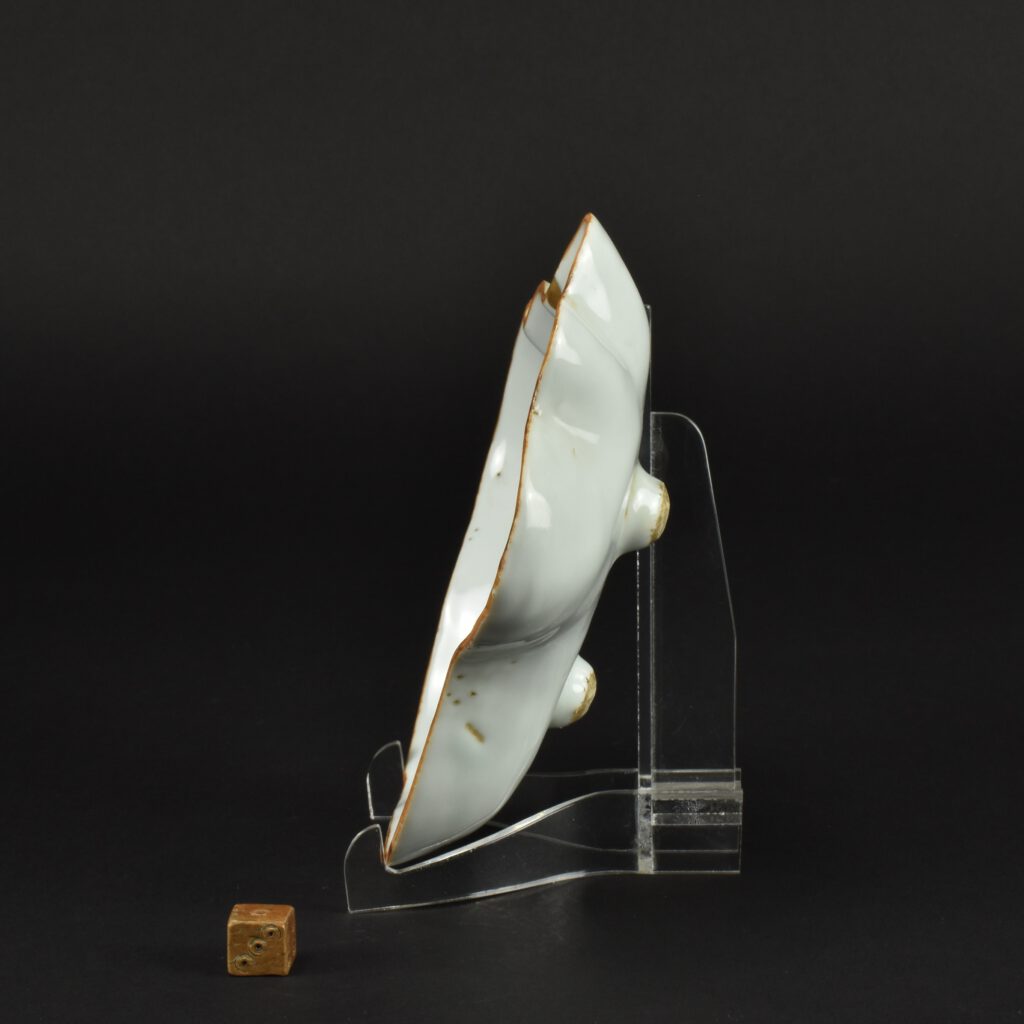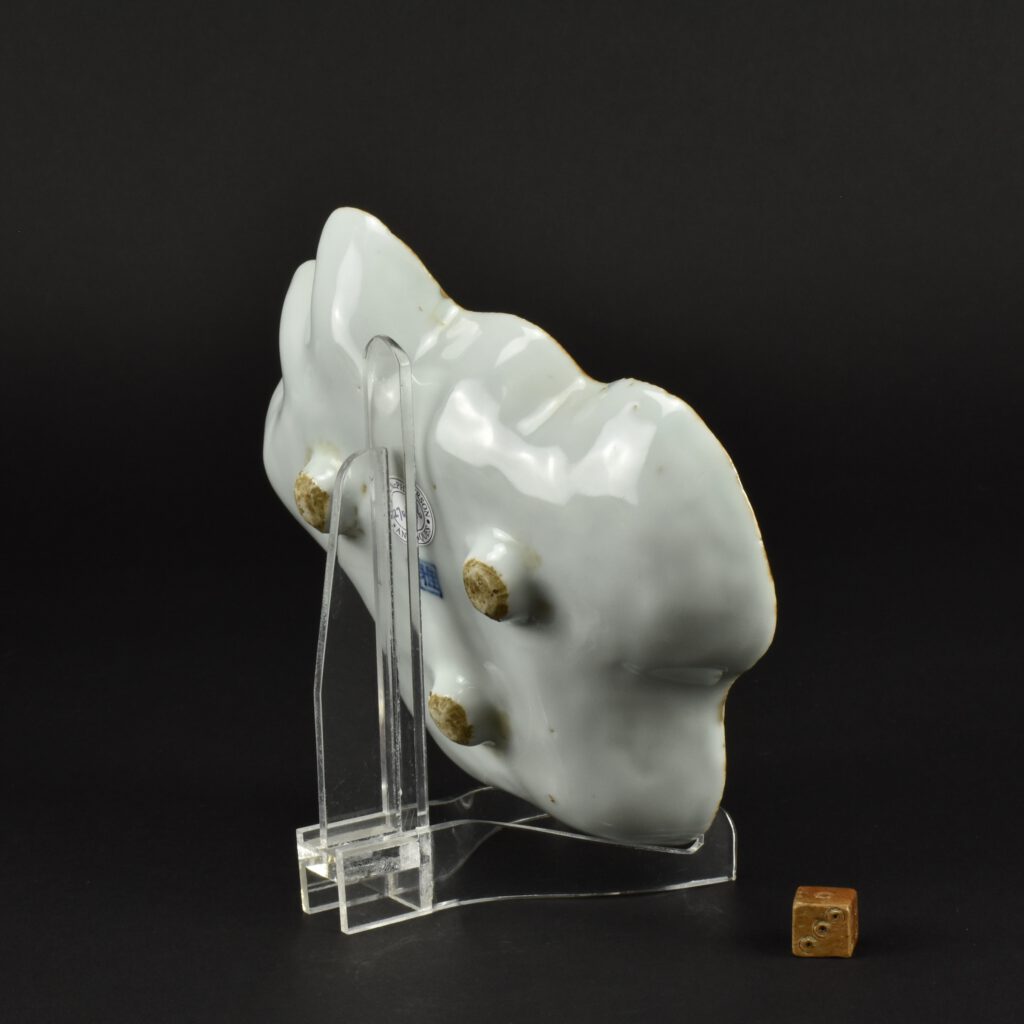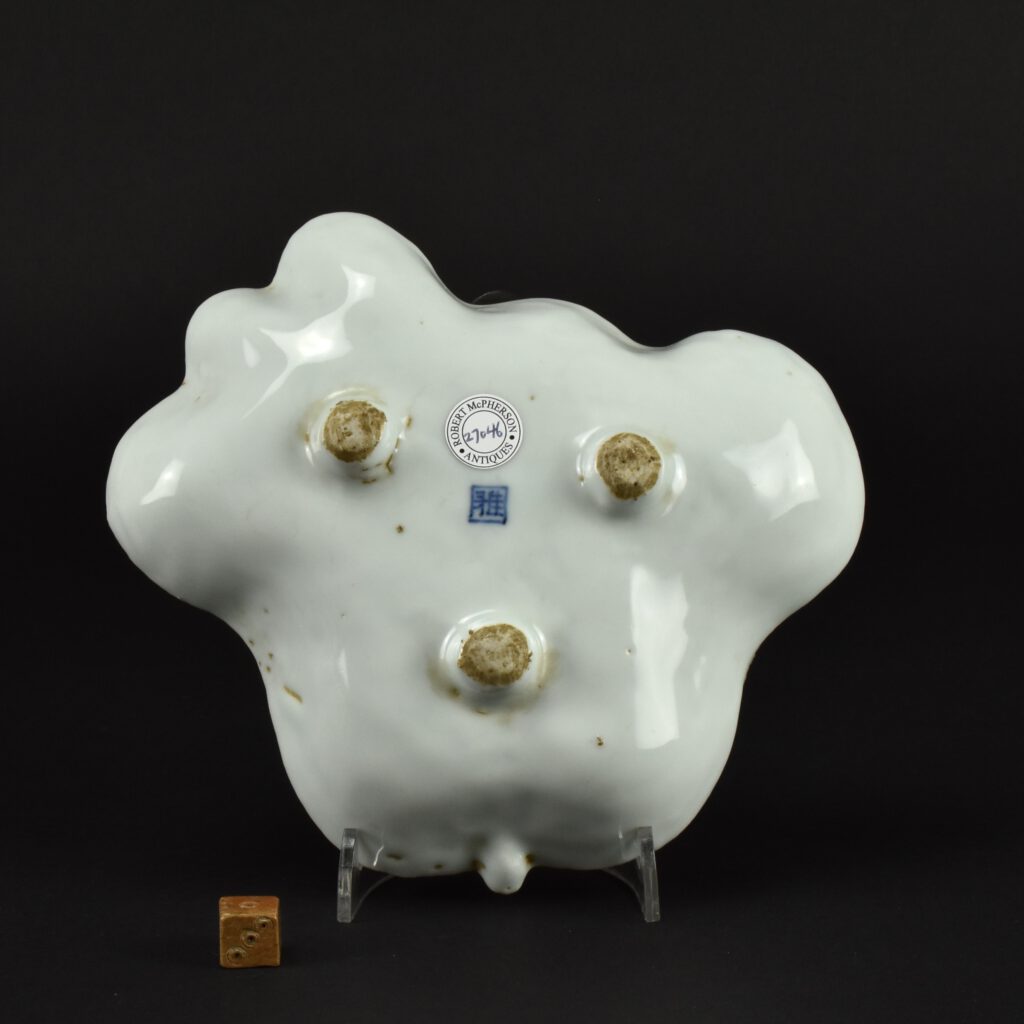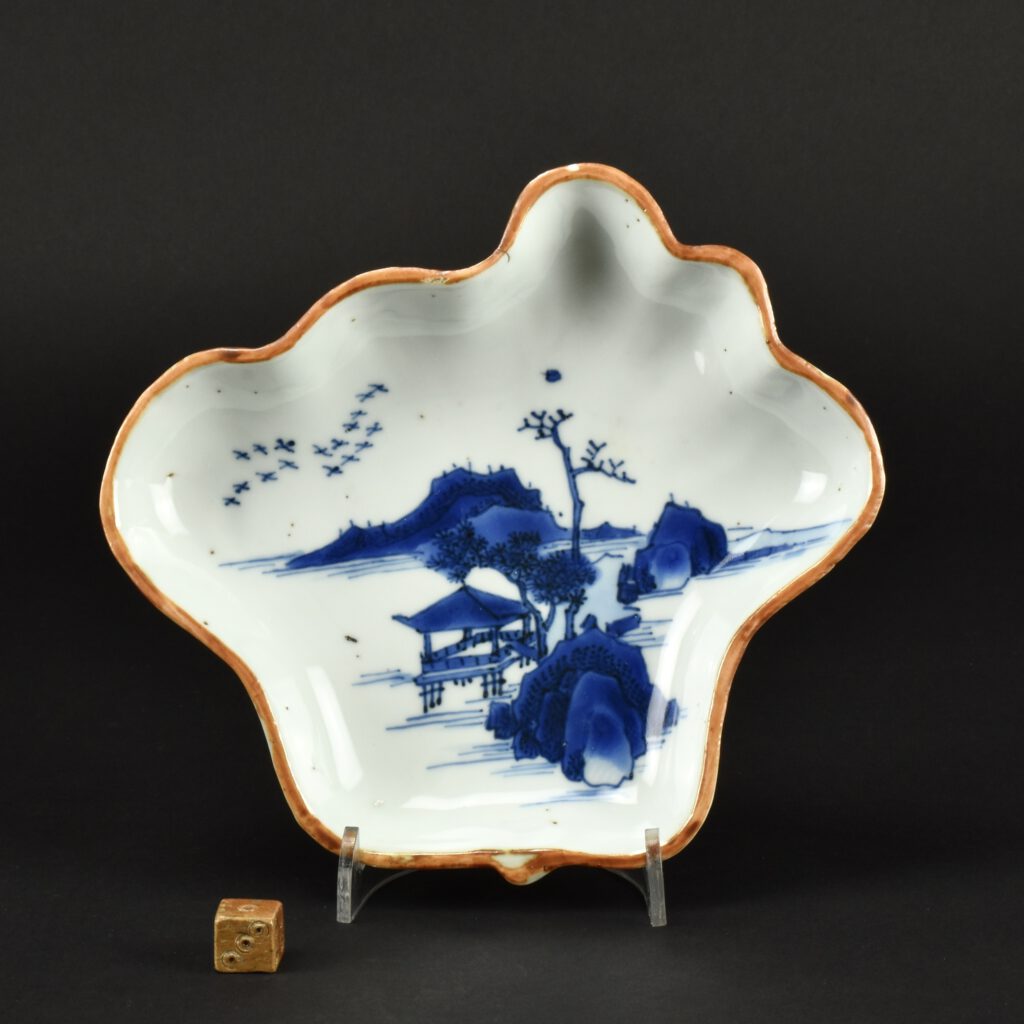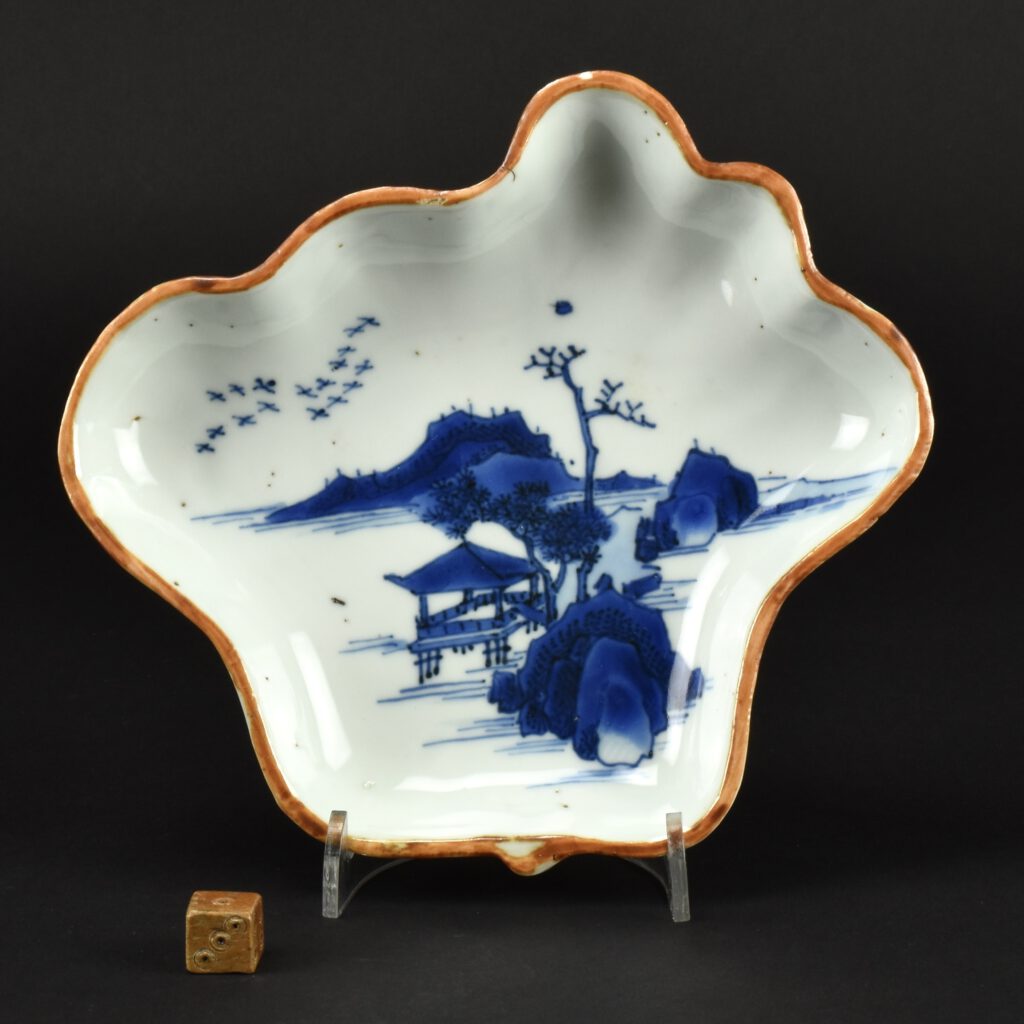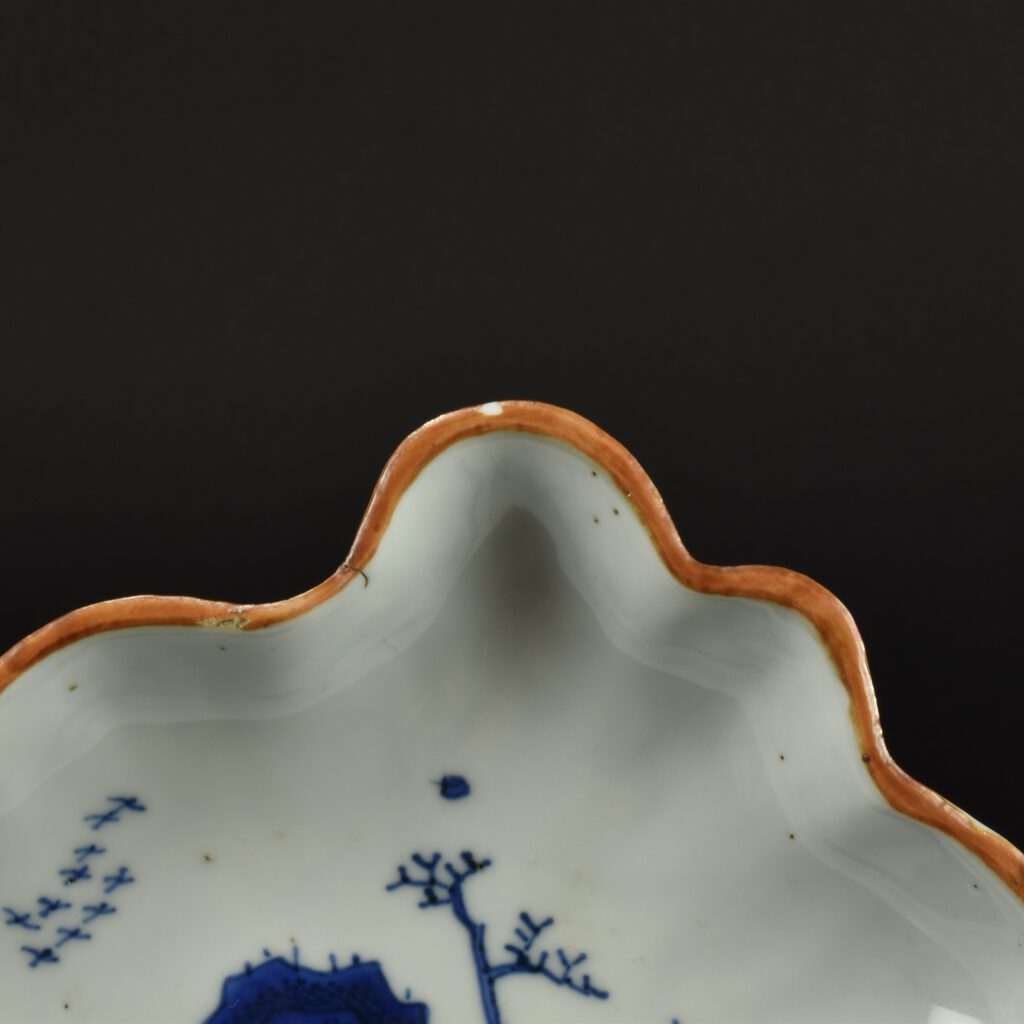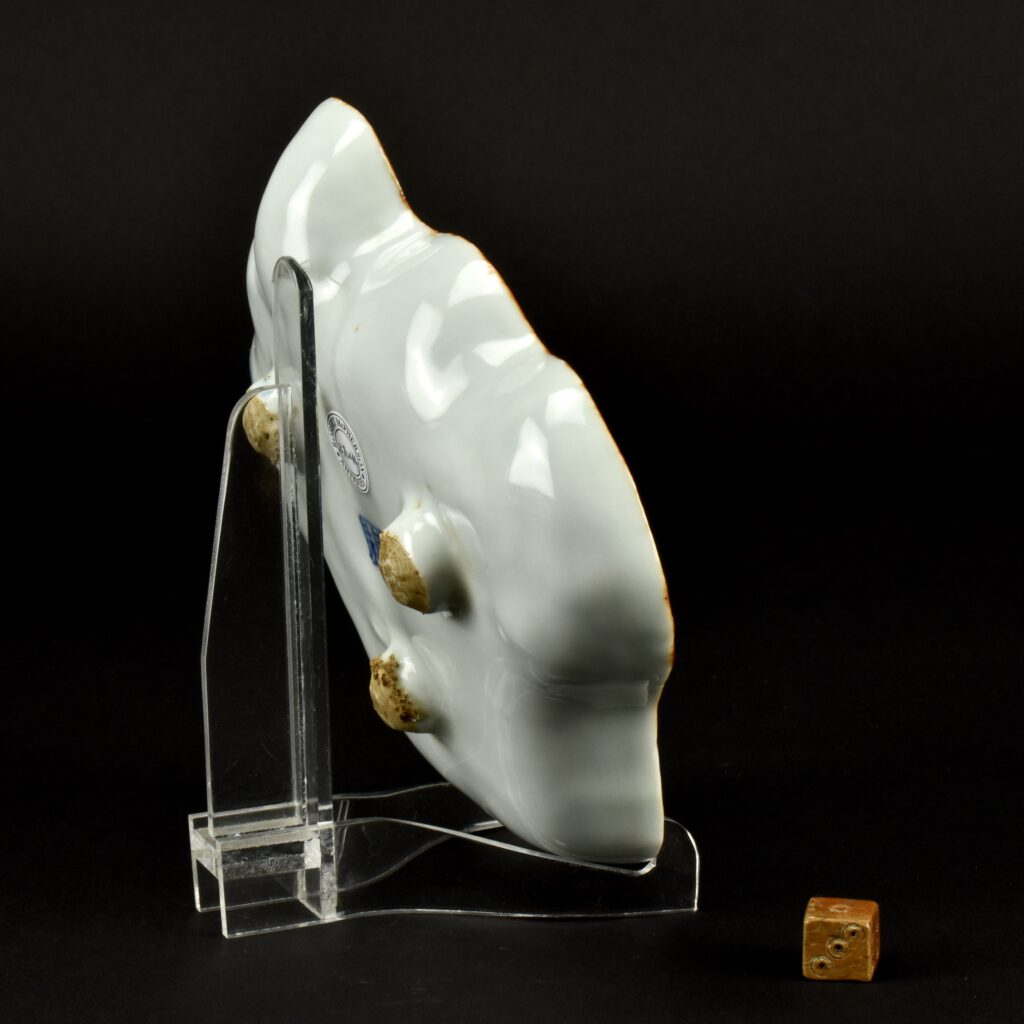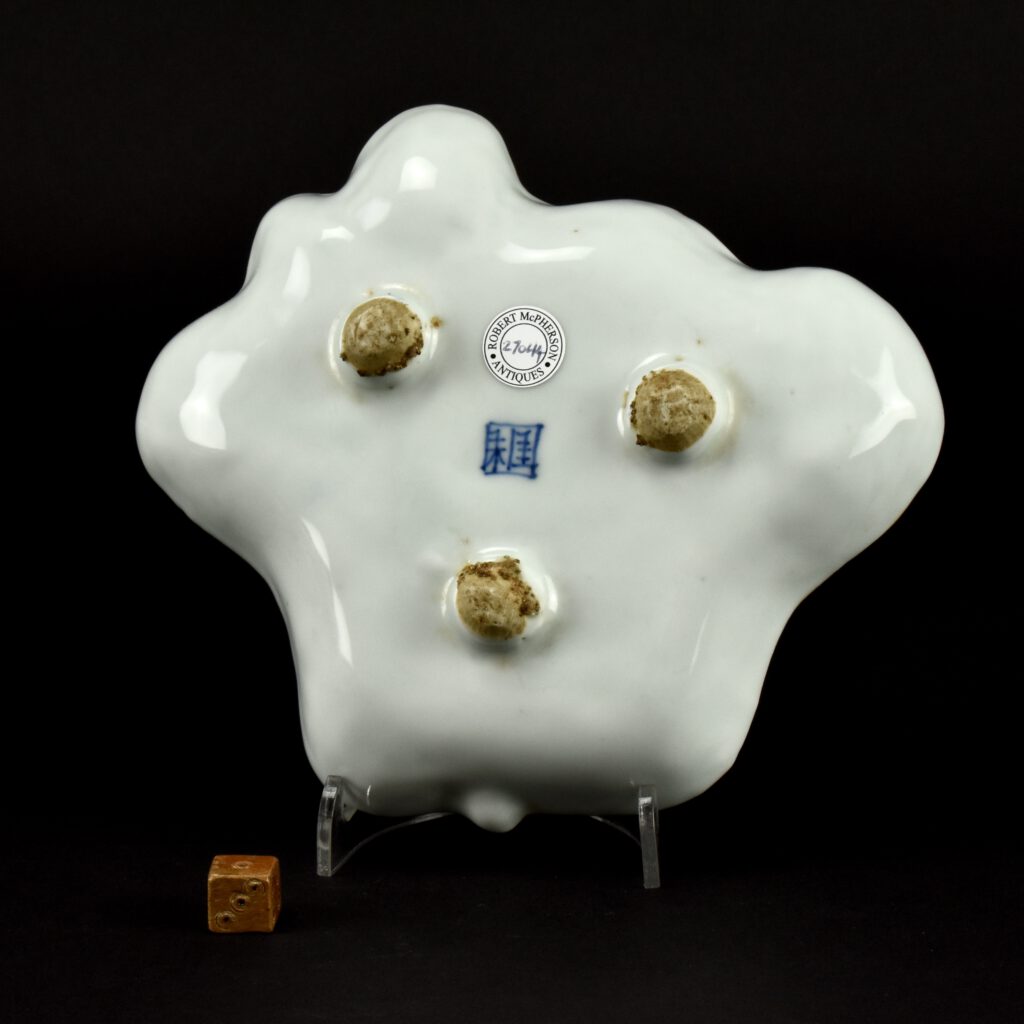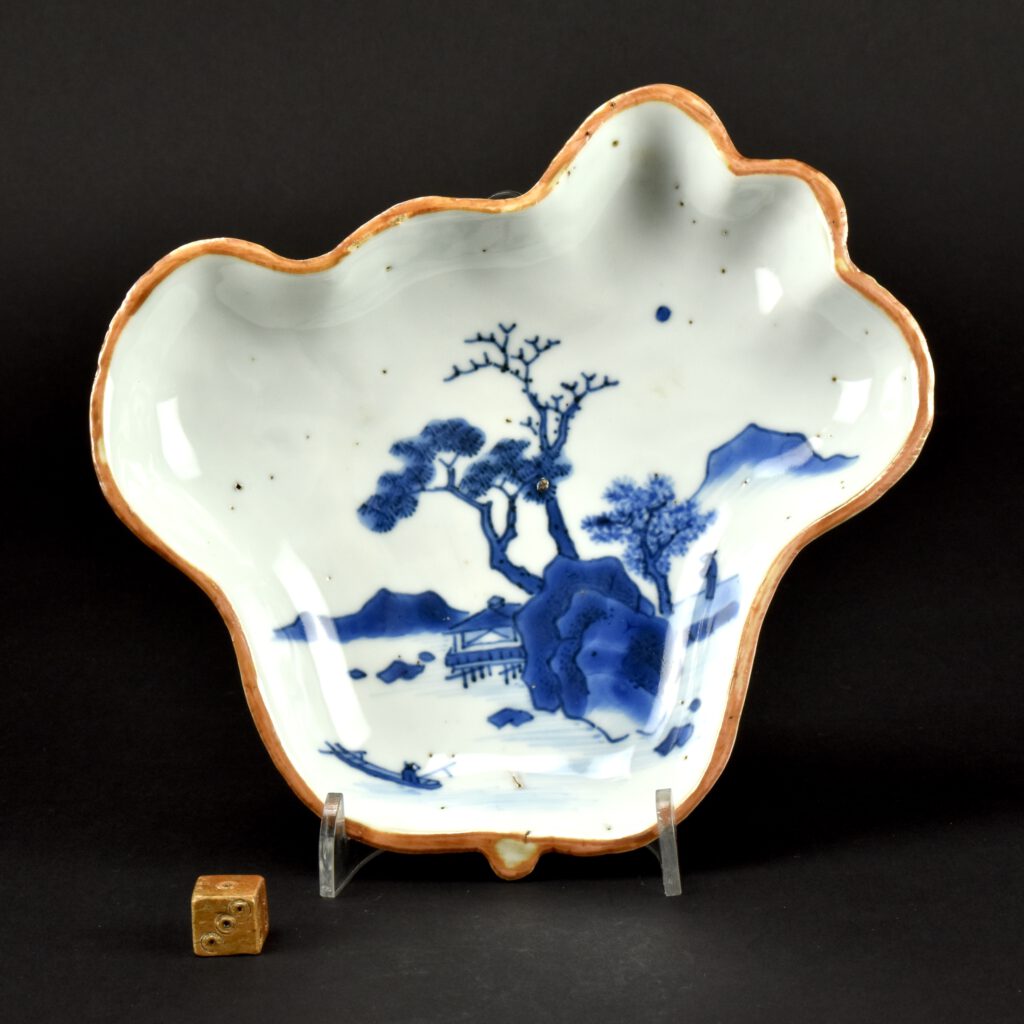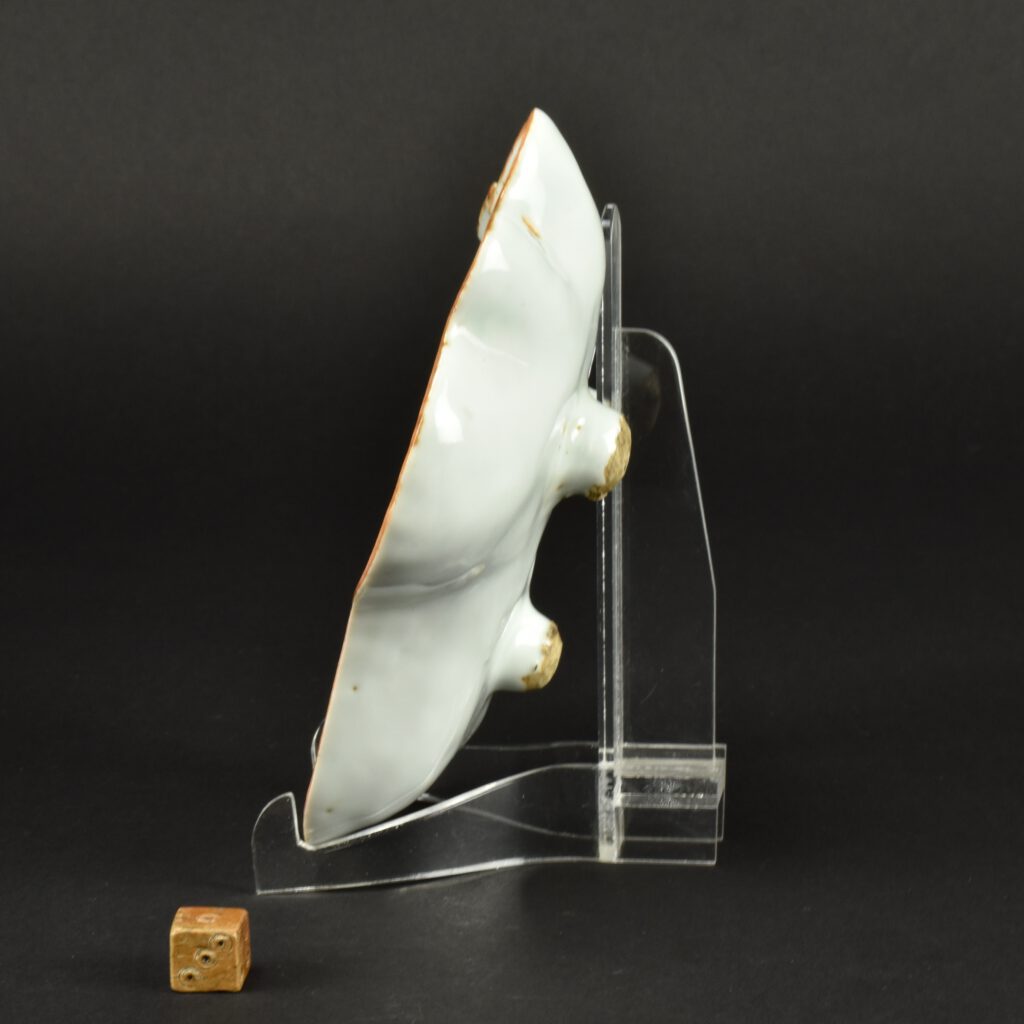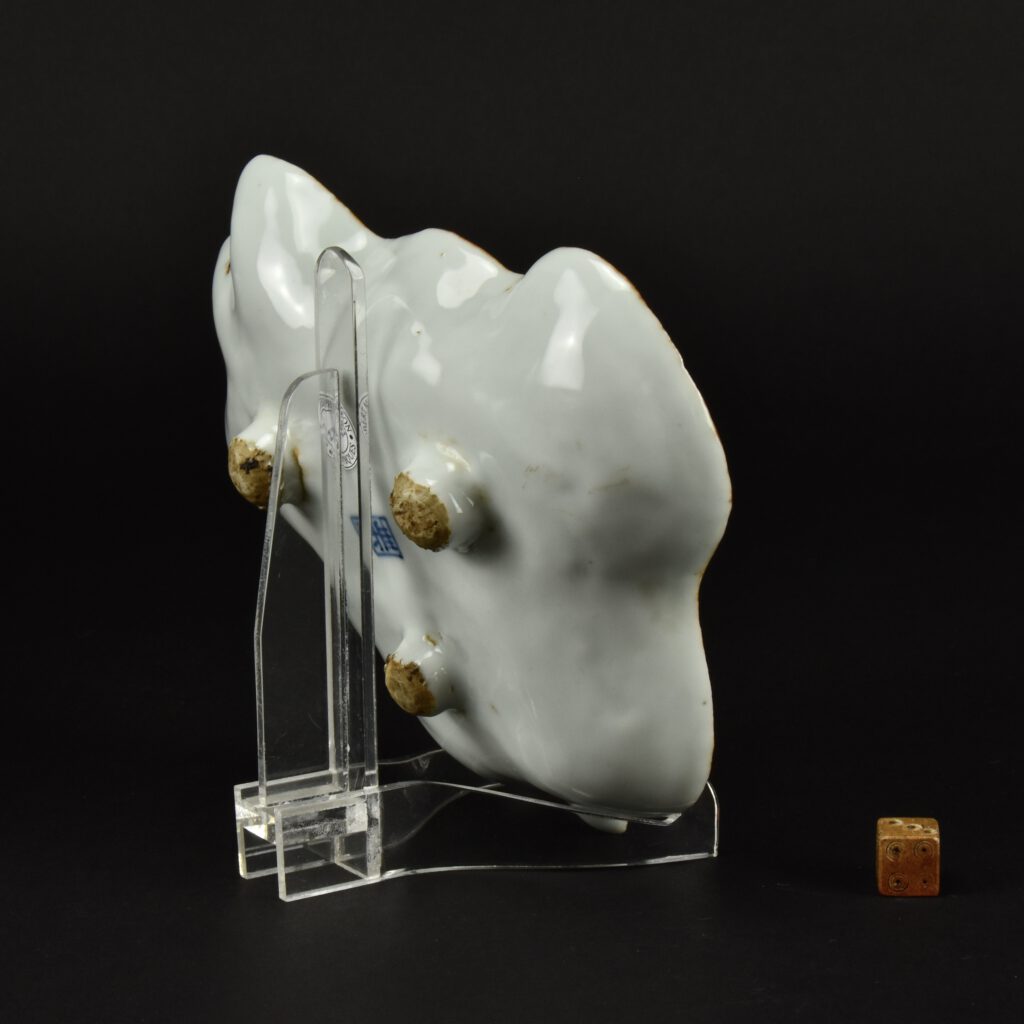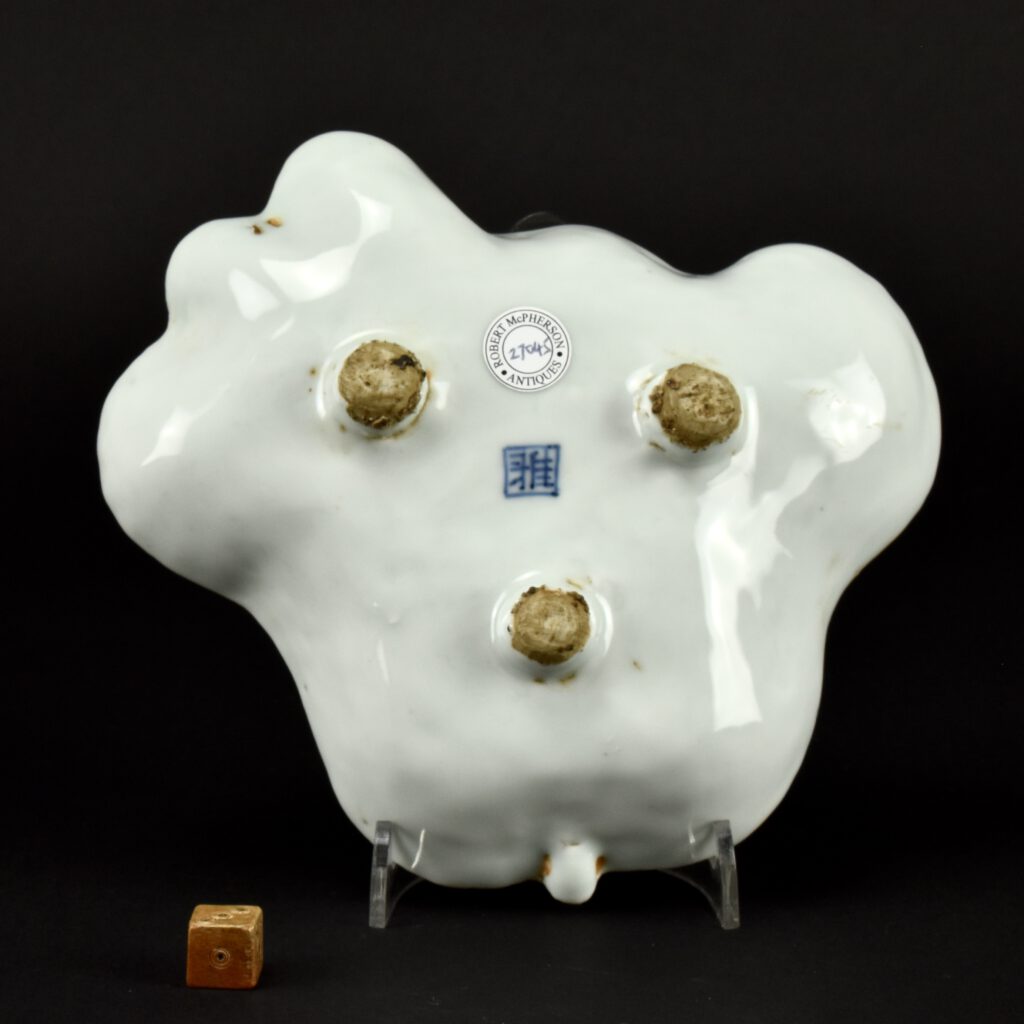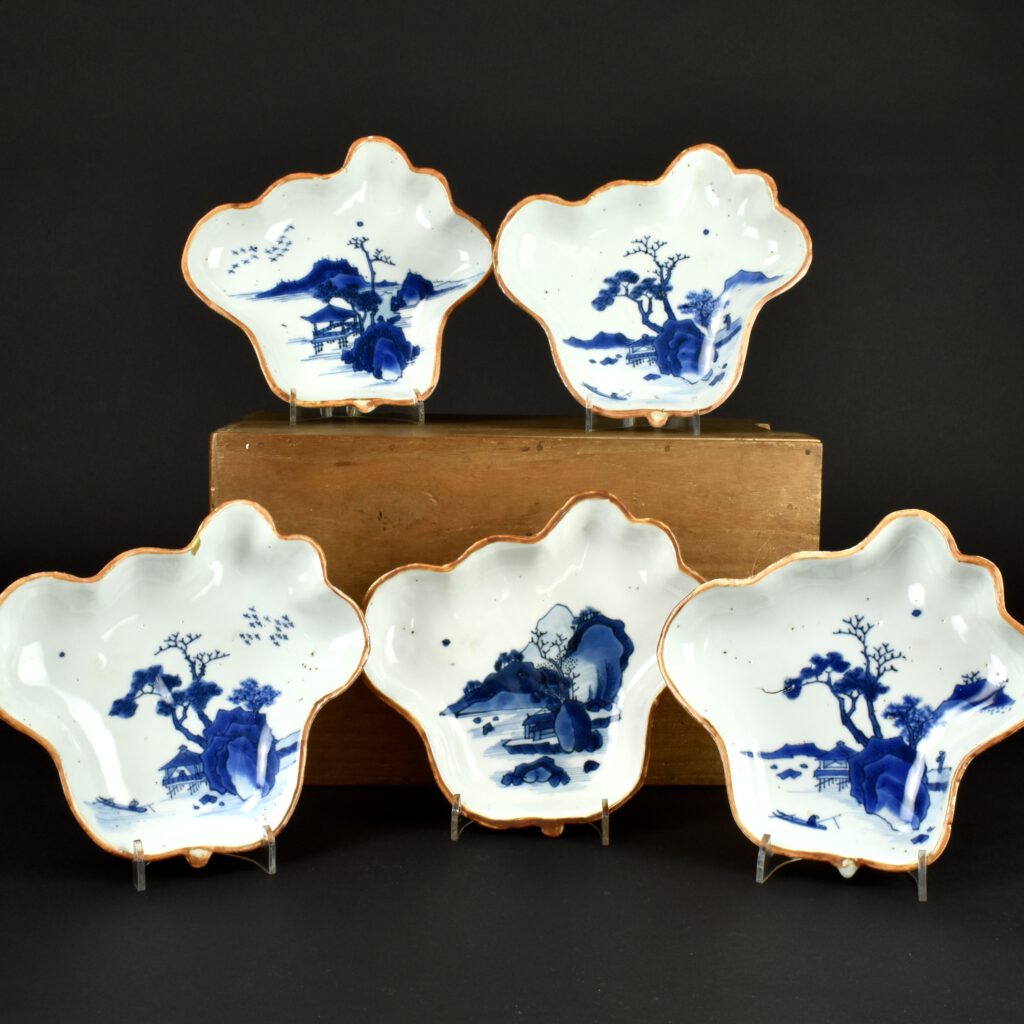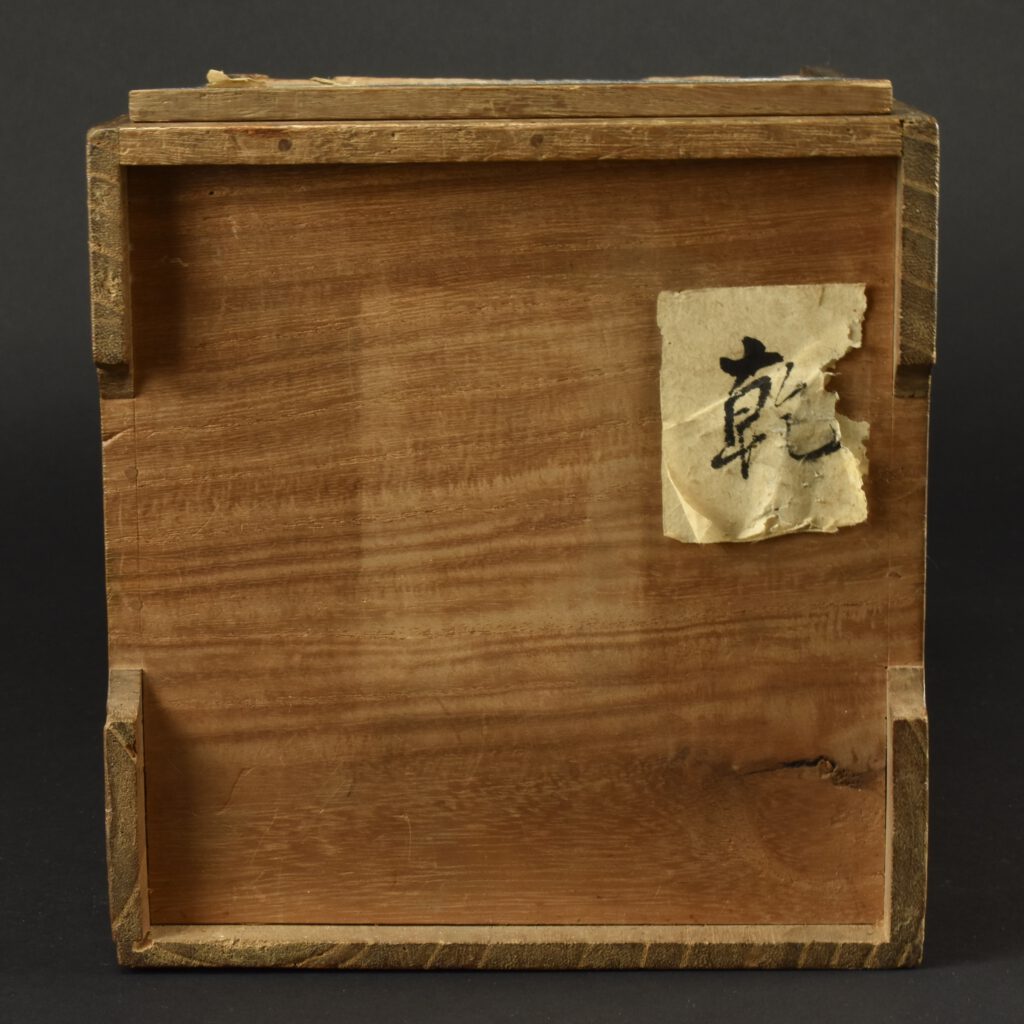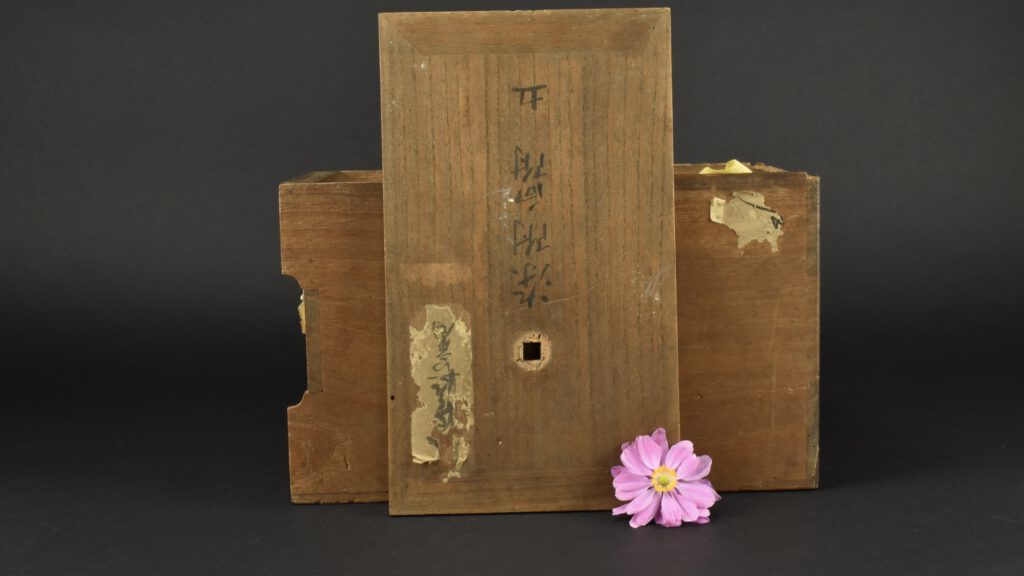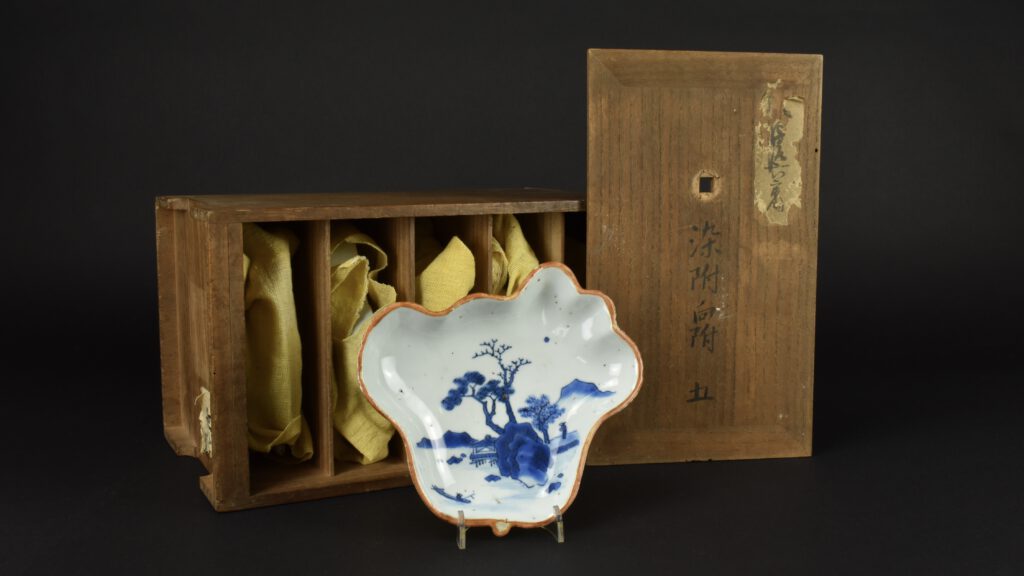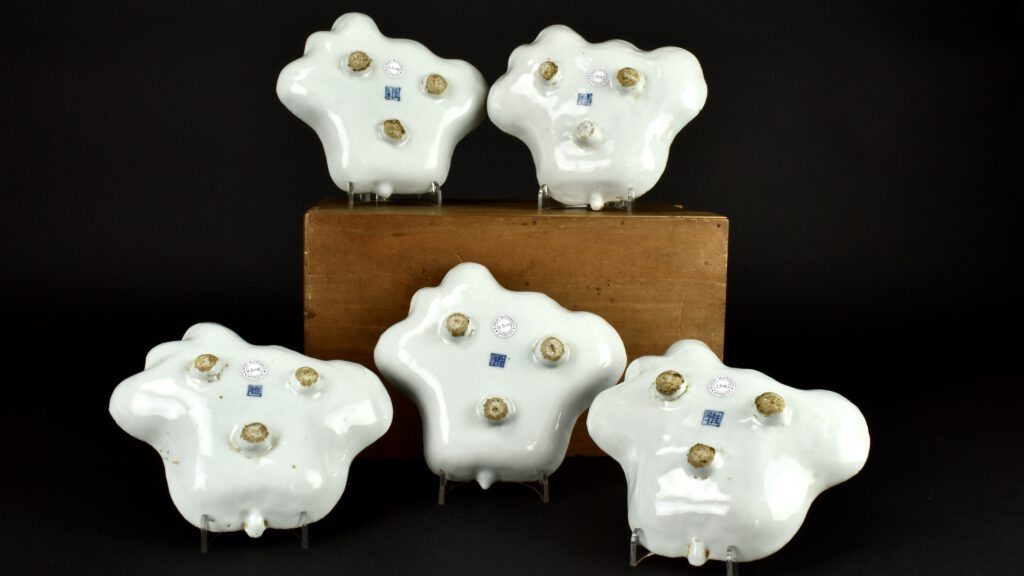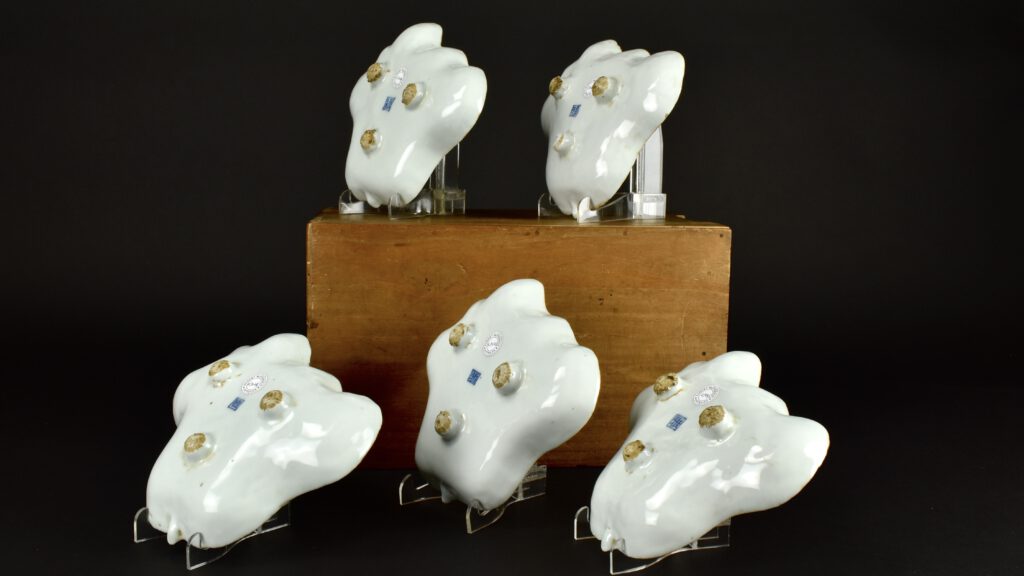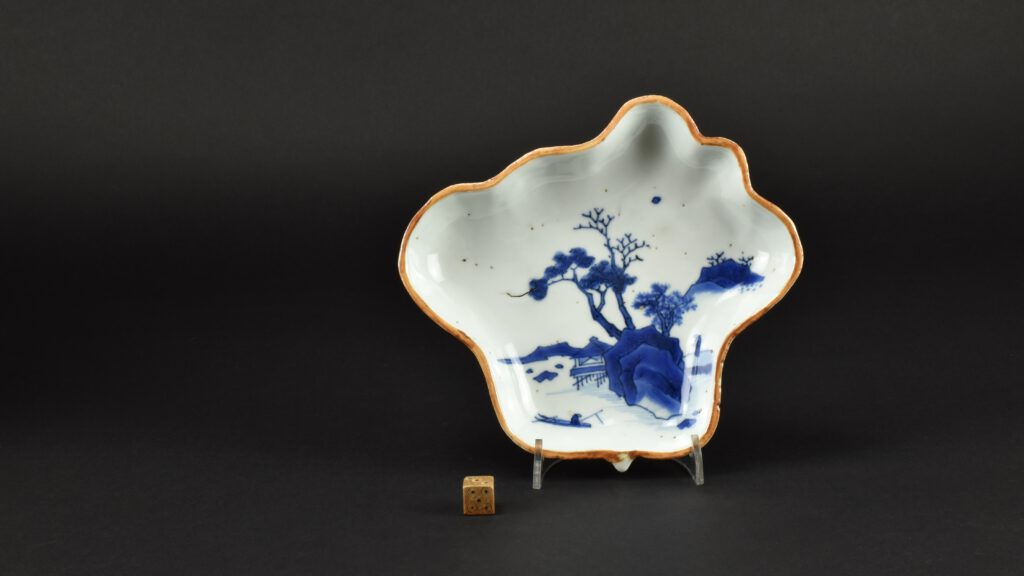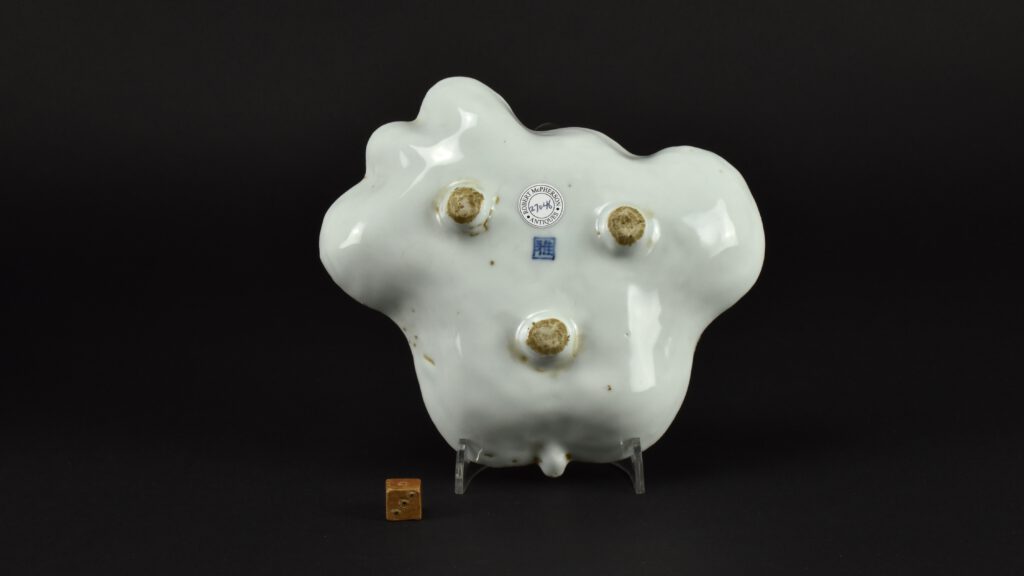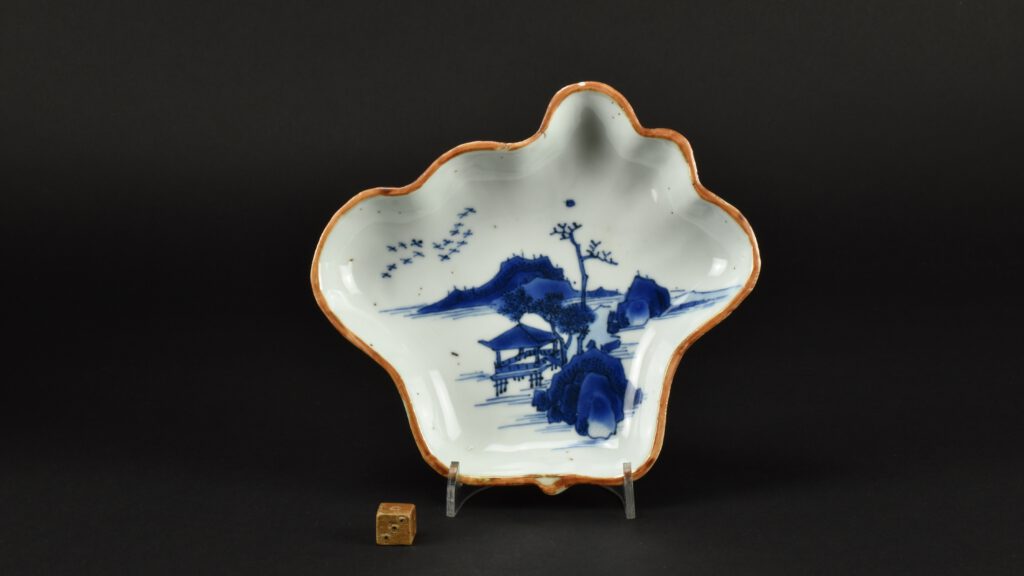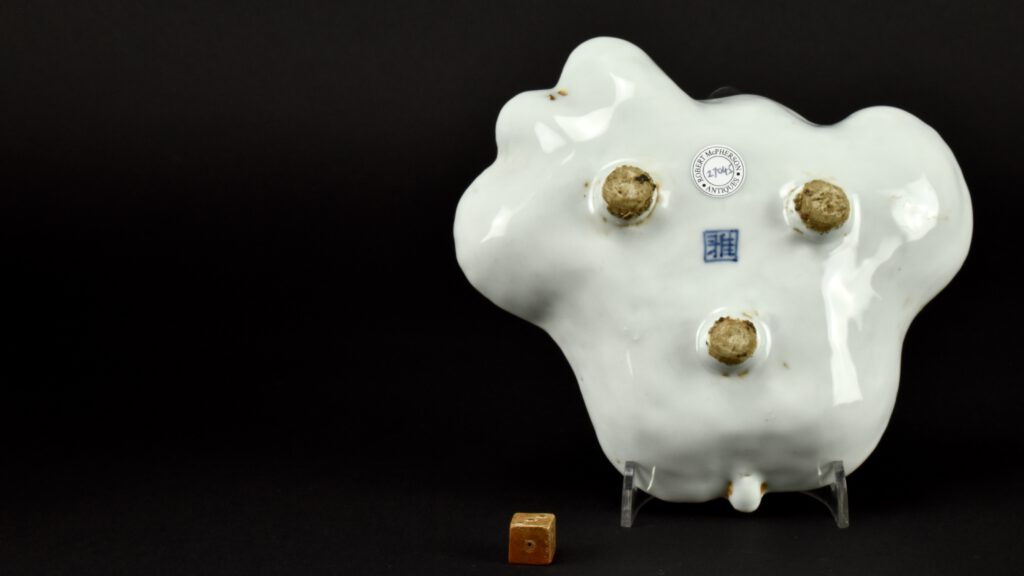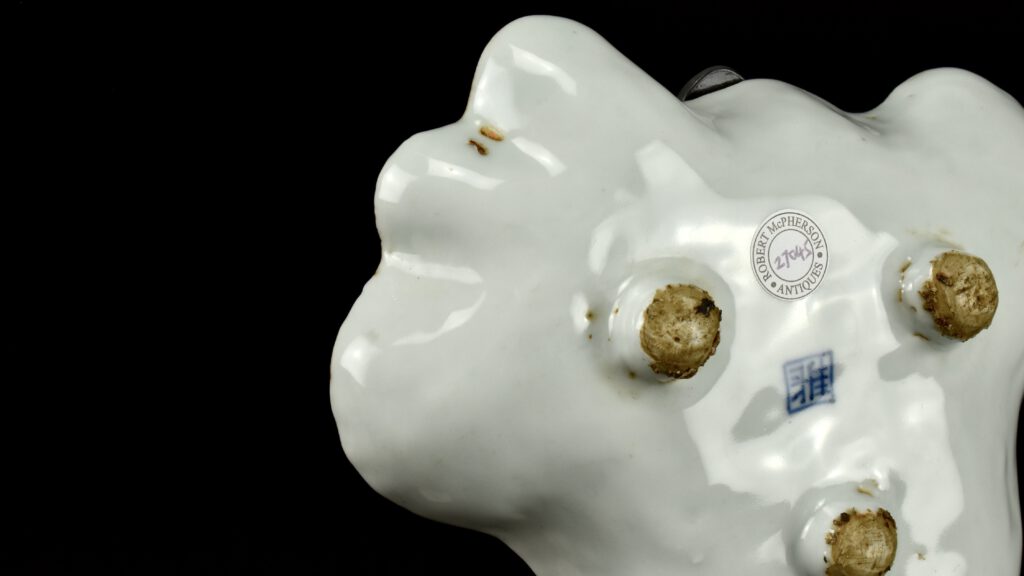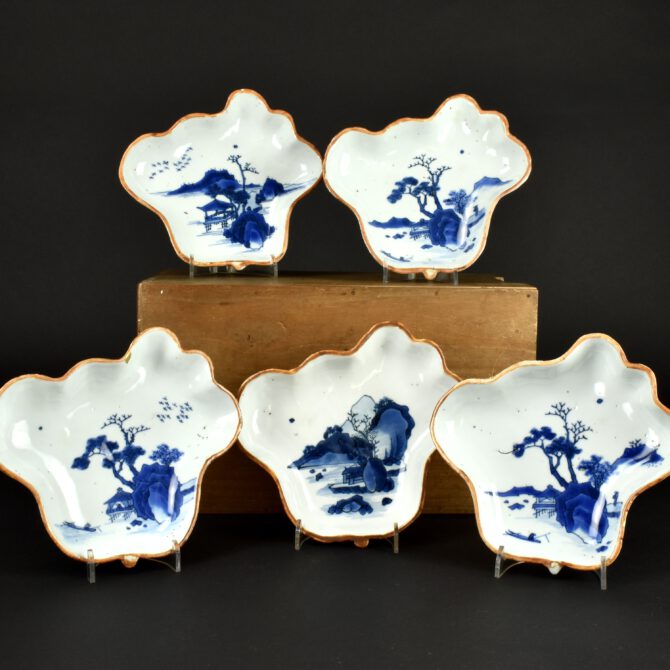
Rare Complete Set of Five Ming Ko-Sometsuke Porcelain Dishes
A Rare Complete Set of Five Ming Ko-Sometsuke Dishes, Jingdezhen Kilns, Chongzhen Period 1628 – 1644. I have dated these dishes to Chongzhen c.1640, rather than earlier, for a number of reasons. The blue is more vibrant than porcelain from the Tianqi period, the rocks are shaded differently and they have lines of small strokes or dots as shading. These points indicate to me that the are from the ‘High Transitional’ period of around 1640. It is interesting to see that none of the four dishes illustrated in the catalogue ; Chinese Porcelain for the Japanese Market, Ko-Sometsuke (Jorge Welsh Books, 2013, see references) match any of the five in this set, indeed, the placing of the landscape is on the opposite side. The dishes of both sets are marked with the Chinese character Ya meaning refined or elegant. This set of five late Ming tripod dishes (mukozuke) were mould made in the form of an asymmetrical leaf, supported on thick stubby feet with rounded unglaze ends. The flattened edges are dressed with a pale iron oxide glaze. Unusually, these scenes are all different, but based on very similar themes, and layout. They depict moonlit wintery scenes, with imposing mountainous landscapes surrounded by water. Each dish shows overlapping rocks and mountains, with a small rustic building, or in the case of one dish, several buildings. Two dishes have flocks of birds, and two dishes show a small low craft on the water with a solitary fisherman. The landscape is harsh, the rocks are jagged and among them humans are small, inconsequential, their boats and dwellings modest, overpowered by the natural world around them. These themes relate to the Japanese theory of Wabi-Sabi. A literal translation doesn’t work well for the Japanese concept known of Wabi-Sabi. We have imprinted in us a sense of permanence connected with the Classical Order, symmetry, things being right, perfect, pristine even. We know an Imperial Qing or Sèvres vase is good quality because it tells us so. The material, fine translucent porcelain, is decorated in rich colours, even gold, the surface filled with decoration that wears its wealth in clear public view. It is perfect and perhaps if we own it will get somewhere nearer perfection ourselves. The Japanese aesthetic of Wabi-Sabi shows us something quite different. Life is imperfect, we are imperfect, the art of life is to live with imperfection. Perhaps, the nearest we get to permanence is the inevitable realisation that transience is part of the ebb and flow of how things are. Nothing is perfect, Wabi-Sabi allows us to see the beauty inherent in imperfection, the rustic and the melancholy. A potter’s finger marks on the surface of a pottery bowl, the roughness of a pottery. A ceramic surface can become a landscape in which the eye walks over humble cracks, uneven, with faults, the mind in austere contemplation. Wabi-Sabi can be condensed to ‘wisdom in natural simplicity’.
See below for more photographs and references.
SOLD
- Condition
- Excellent Condition : 27042 - No damage. 27043 - No damage (tissue paper on one foot now removed. 27044 - minute rim frit, tiny amount of fritting (see photographs). 27045 - very tiny amount of fritting. 27046 - Kintsugi repair with a short fine hairline (see close up photographs).
- Size
- Approximate Width left to right - 16.7 cm (6 1/2 inches) Approximate Width top to bottom - 15 cm not including the stalk (5 3/4 inches) Approximate Height - 3.5 cm (1 3/4 inches)
- Provenance
- N/A
- Stock number
- 27042
- References
- For a very similar, but incomplete set of four dishes dated to c.1625-1635, see : Chinese Porcelain for the Japanese Market, Ko-Sometsuke (Jorge Welsh Books, 2013. ISBN 978-0-9573547-0-8) page 62, plate 13.
Information
Ko-Sometsuke is a term used to describe Chinese blue and white porcelain made for Japan. This late Ming porcelain was made from the Wanli period (1573-1620), through the Tianqi period (1621 - 1627) ending in the Chongzhen period (1628-1644), the main period of production being the 1620'2 and 1630's. This porcelain made in China for Japanese reflected a rise in interest of the Japanese tea ceremony but it also coincided with the beginning of porcelain production in Japan (from c.1610/20). The porcelain objects produced in China were made especially for the Japanese market, both the shapes and the designs were tailored to Japanese taste, the production process too allowed for Japanese aesthetics to be included in the finished object. Its seems firing faults were added, repaired tears in the leather-hard body were too frequent to not, in some cases, be deliberate. These imperfections as well as the fritted Mushikui (insect-nibbled) rims and kiln grit on the footrims all added to the Japanese aesthetic. These imperfections were something to be treasured by the Japanese, they reflect an imperfect world and the aesthetics of Wabi-Sabi. These 'faults' was an anathema to the Chinese but they went along with it to satisfy the needs of their Japanese customers. The shapes created were often expressly made for the Japanese tea ceremony, especially the meal associated with tea drinking, the Kaiseki. Small dishes for serving food at the tea ceremony are the most commonly encountered form. Designs, presumably taken from Japanese drawings sent to China, these are very varied and often extremely imaginative. They often used large amount of the white porcelain contrasting well with the asymmetry of the design, sometime the Chinese couldn't help themselves but to fill in these gaps with 'excess' decoration. Many other forms were made, among them are charcoal burners, water pots, Kōgō (incense box) as well as variously shaped dishes in the form of fish, fruit or familiar country animals.
A Related Leaf Shaped Ko-Sometsuke Porcelain Dish
Robert McPherson Antiques : Sold Archive, Item 24621.
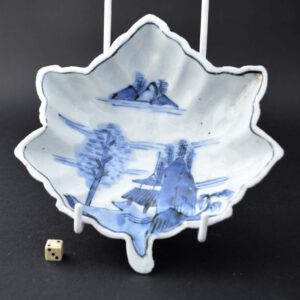
A Related Set of 17th Century Japanese Porcelain Dishes
Robert McPherson Antiques : Stock Number 26677.
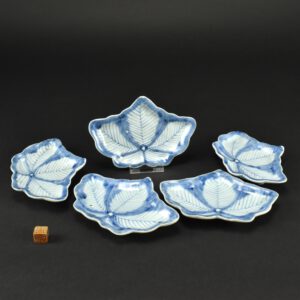
A Related 17th Century Japanese Porcelain Dish
Robert McPherson Antiques : Sold Archive, Item 26572.
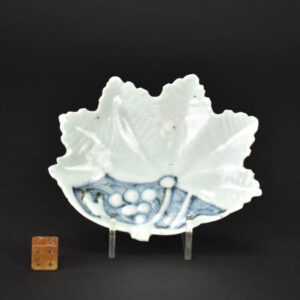
SOLD
Condition
In good condition, a small chip to the end of the end of the top leaf point, small glaze losses to the lower left leaf point. A minute chip to the lower rim just below the end of the blue decoration on the right-hand side. A minute chip to the back edge.
Size
10.7 cm (4 1/4 inches).
Stock number
26572
References
For an almost identical dish see : Complete Catalogue of Shibata Collection (Contributors Saga Kenritsu Kyūshū Tōji Bunkakan. Published by the Kyushu Ceramic Museum, 1990) page 43, plate 0283.
Wabi - Sabi A literal translation doesn't work well for the Japanese concept known of Wabi-Sabi. We have imprinted in us a sense of permanence connected with the Classical order, symmetry, things being right, perfect, pristine even. We know an Imperial Qing or Sèvres vase is good quality because it tells us so. The material, fine translucent porcelain, is decorated in rich colours, even gold, the surface filled with decoration that wears its wealth in clear public view. It is perfect and perhaps if we own it will get somewhere nearer perfection ourselves. The Japanese aesthetic of Wabi-Sabi shows us something quite different. Life is imperfect, we are imperfect, the art of life is to live with it. Perhaps, the nearest we get to permanence is the inevitable realisation that transience is part of the ebb and flow of how things are. Nothing is perfect, Wabi-Sabi allows us to see the beauty inherent in imperfection, the rustic and the melancholy. A potter's finger marks on the surface of a pottery bowl, the roughness of a pottery. A ceramic surface can become a landscape in which the eye walks over humble cracks, uneven, faulty, the mind in austere contemplation. Wabi-Sabi can be condensed to 'wisdom in natural simplicity'.
Wabi-Sabi stems from from Zen Buddhist thought, 'The Three Marks of Existence' ; impermanence, suffering and the emptiness or absence of self-nature. These ideas came to Japan from China in the Medieval Period, they have developed over the centuries and have greatly affected Japanese culture. For example the Japanese tea ceremony, which is the embodiment of perfection, uses ceramics which are imperfect. It was not just the pottery made in Japan that needed to have a Wabi-Sabi nature but also the Chinese porcelain made for the Japanese tea ceremony. During the late Ming dynasty the Chinese supplied Japan with porcelain for the tea ceremony, not just for the ceremony itself but for the meal that was taken with it, the Chinese even supplied charcoal burners for them to light their pipes. This Chinese porcelain was made at Jingdezhen to Japanese designs, sent from Japan. The Japanese wanted the Chinese to work against their normal way, they requested firing faults, imperfections and unevenness. The Chinese were sometimes rather too precise in their making of these imperfections, often adding faults carefully and even symmetrically. I imagined they could have thought, 'why do our customers want us to make these things so badly'. Clearly Wabi-Sabi was lost on them.
